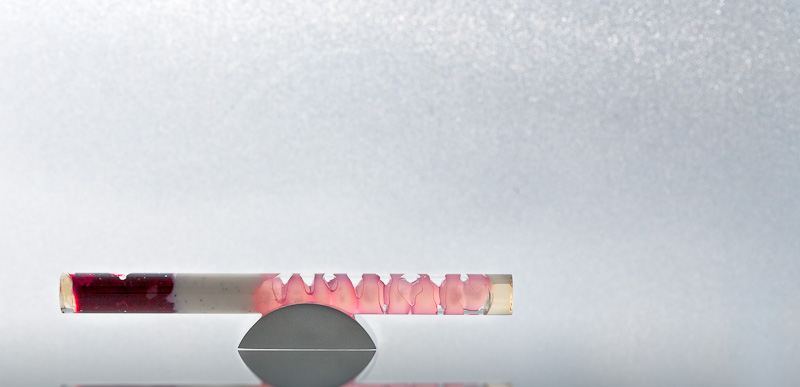
Happy (extremely-belated) New Year!
Many of my New Year’s resolutions revolve around this project; I deliberately took a break from it over the holiday season to reflect a bit on it and decide how I’d like to approach it this year.
I have a tendency (which I increasingly dislike) to compare myself to others in unfairly-competitive ways. At work, I tend to look around at peers who are my age and take note of things like their job titles and mentally check to see if I’m ‘ahead of’ or ‘behind them’ in terms of career progress. At the studio at which I previously worked, this demon ultimately consumed me; I got into this spiral of constantly comparing myself to other friends who had joined the studio around the same time I did, who ultimately ‘passed me up’ in terms of title/responsibility/salary, and rather than focusing on just doing good work, I lost myself in a sea of worry about how much I saw myself as ‘lagging’.
A good friend of mine in New Zealand noticed me struggling with this, and lamented aloud to me one day “You’re just all wrapped up in your head about this. I remember when you first got here, you were just fascinated by doing cool shit. All your forward progress came from that. But you’re not interested in the ‘doing cool shit’ bit anymore, you’re just worried about the ladder-climbing, and that’s why you’re inherently not doing it well.” The observation and implied advice was clear and memorable.
From the start of this project, I’ve sought to do a good job with it. “A good job” has turned into a moving target for me, and defining it has been the source of no small amount of thought over the past few weeks. Initially, “a good job” involved making something from the Alinea cookbook that was simply edible. This quickly evolved into making something that was pretty, and closely-resembled what I see in the book. Simultaneously, I started learning how to taste things more sensitively, and “a good job” involved tweaks and adjustments to yield a final product that tasted as good as possible.
Once I started getting the hang of things, doing “a good job” took a turn for the vague. At times it’s been about comparing myself to others working through this cookbook or even other chefs who do this professionally; I want to be able to keep up and when I can’t I get down on myself about it. It’s also drifted towards seeking recognition, trying to go fast, or any number of other motivations symptomatically stemming from a desire for popularity. I got jammed up trying to rip through recipes quickly, thinking this might indicate I was ‘doing it well’ while simultaneously worrying about seeming stagnant, letting too much time pass between writings, or otherwise being slow, which I equate with ‘potentially-uninteresting’ to anyone who reads this.
All of this was largely fruitless and came at the cost of gaining a deeper understanding of things, taking time to explore and experiment, and generally being thorough to my own satisfaction.
Reflecting on this led me to see the dangers of it. Doing anything for the sole purpose of seeking popularity or approval is lame, and ultimately makes one wholly a servant to the opinions of others. Most Cool Shit I tend to be attracted to stems from someone doing something they really love, really well. This, in fact, was the whole reason I started doing this in the first place: because I saw some guys in Chicago doing Cool Shit and I wanted to play too.
My resolutions, then, involve letting go of the sense of competition, trying to be ok with being patient, and keeping tabs on my motivations for my decisions. I hope that through this I’ll find growth rather than simply pushing up numbers on my “How many dishes have I finished?” list.
(a side note: I’ve read and reread, edited and re-edited the above sentiment for weeks before ultimately deciding that part of doing a good job involves being honest).
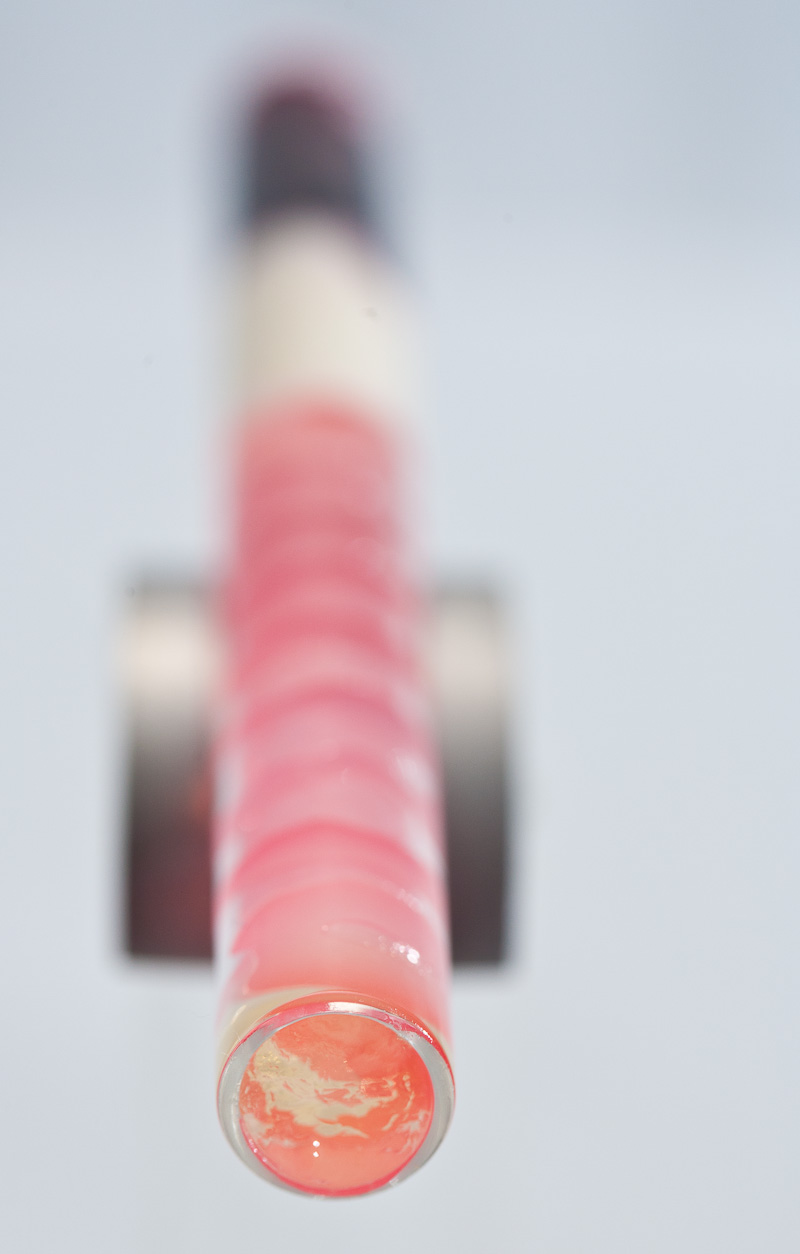
To that end, I’ve spent the past few months researching and working on something I’ve wanted to do for a while: make a service piece. I’ve wanted to gain a greater appreciation for the complexities of manufacturing the amazing serviceware Alinea uses, and what better way than to dive in and make something of my own?
“My own” is a little bit of a misnomer: when we ate at Alinea last year, one of the more compelling courses for me was what I’ll call “The Bubblegum Tube”. The course is comprised of tapioca pearls flavored of bubblegum sitting inside a glass tube; the tapioca is paired with hibiscus, creme fraiche, and long pepper gel. It was delicious, and I couldn’t get over how cool the presentation was.
Crucial Detail doesn’t sell this piece as a product. This isn’t surprising; it’s just a little glass tube. I wanted to try recreating it, but wanted to augment it by making my own ‘pedestal’ for the tube to sit on. Most of Crucial Detail’s serviceware is made of stainless steel, so to keep my piece in the same universe as Alinea’s, I knew I’d need to learn some things about working with metals. My goal was to design and make something that could sit on a shelf alongside Martin’s stuff and look comparable to the many things he’s designed for the restaurant (or, at least, not completely pathetic).
The obvious first step was to go to the source and email Martin himself to ask him some questions. I mentioned to him what I wanted to try to learn, asked if he could offer some clues about what materials I should be searching for, and what manufacturing and finishing processes I should familiarize myself with. He answered–as always–directly and richly, offering up clues about the process of working with metals.
I needed to first make soem glass tubes. I went back to my friends at Adams & Chittenden to describe to them what I was after. My description was “about the diameter and length of a Sharpie”. I picked this after grabbing several pens and otherwise straw-shaped things sitting on my desk, sticking them in my mouth, and trying to estimate how pleasing they each were to suck on. Adams & Chittenden responded with a suggestion of some borosilicate tubing with an inner diameter of 10mm and an outer diameter of 13mm, and a length of 70mm per tube.
Making the tubes took about a week, and a set of 8 of them cost me around $35. While this work was being done, I started thinking about what I wanted the ‘pedestal’ on which the tube would sit would look like. Knowing absolutely nothing about working with metal, I just started mocking up arbitrary shapes in 3d software. I wanted something that would look balanced and would be nice to touch. I also wanted to keep things simple. I came up with these three designs:
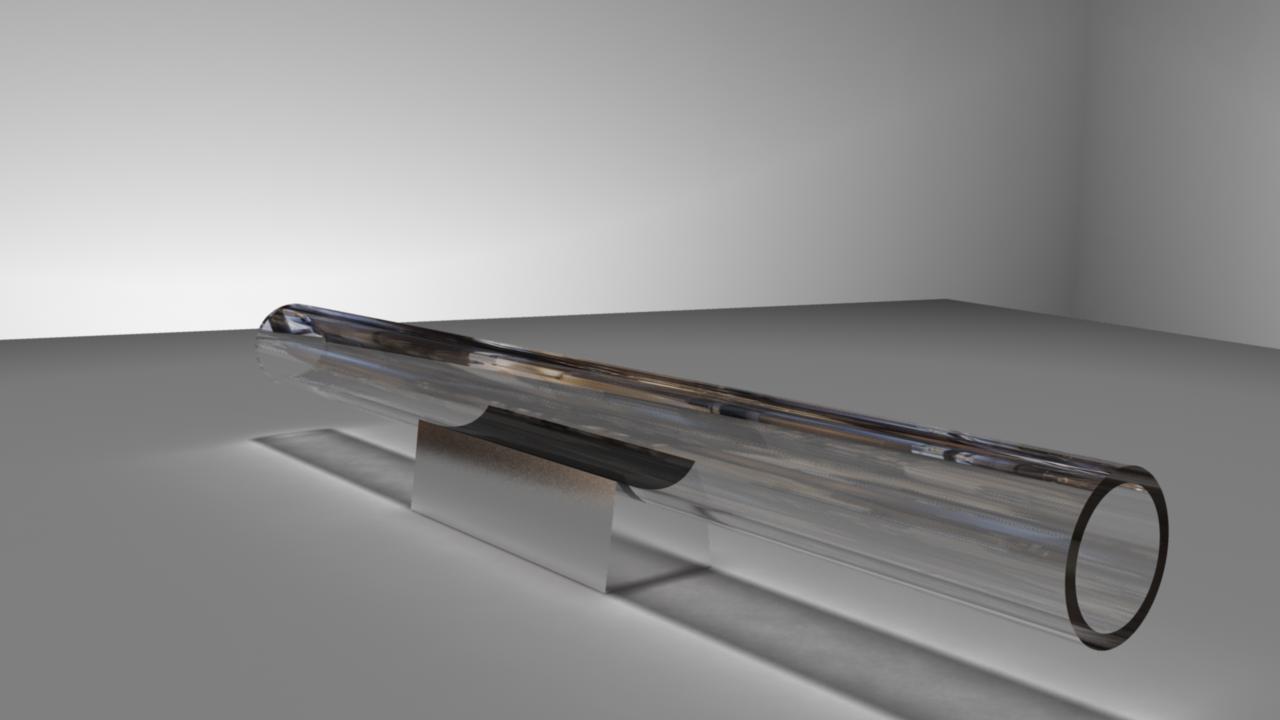
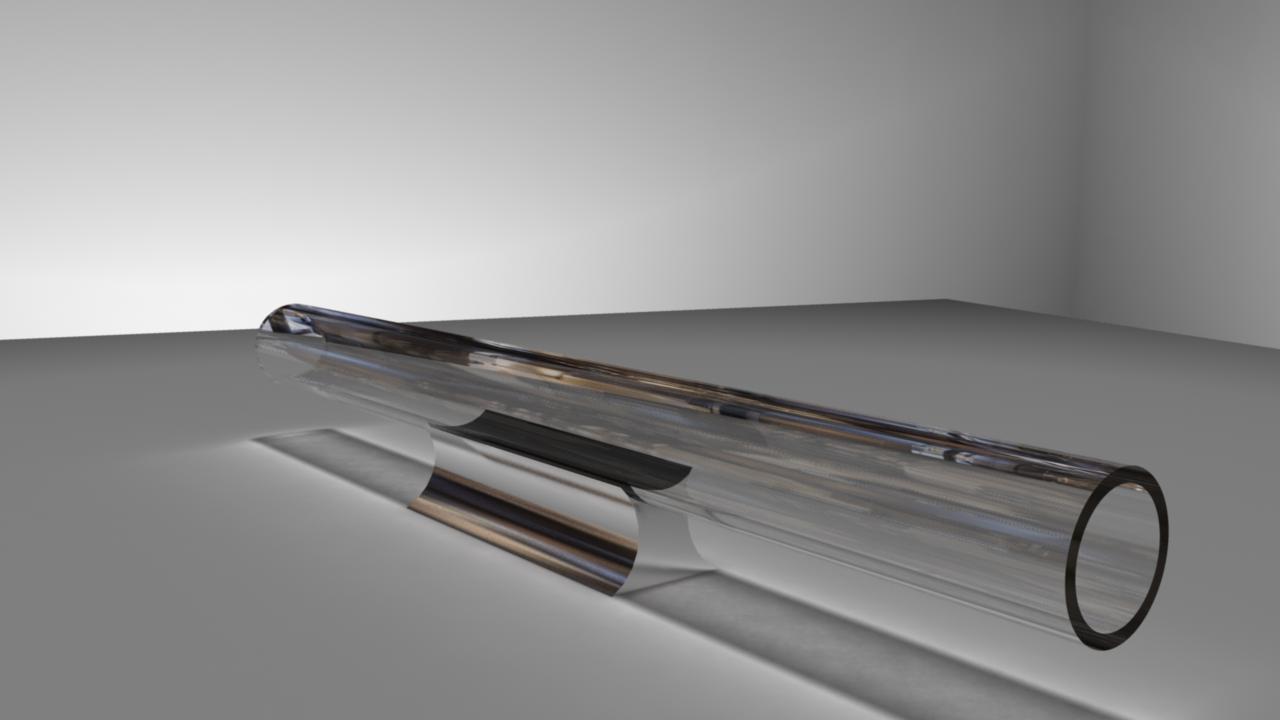
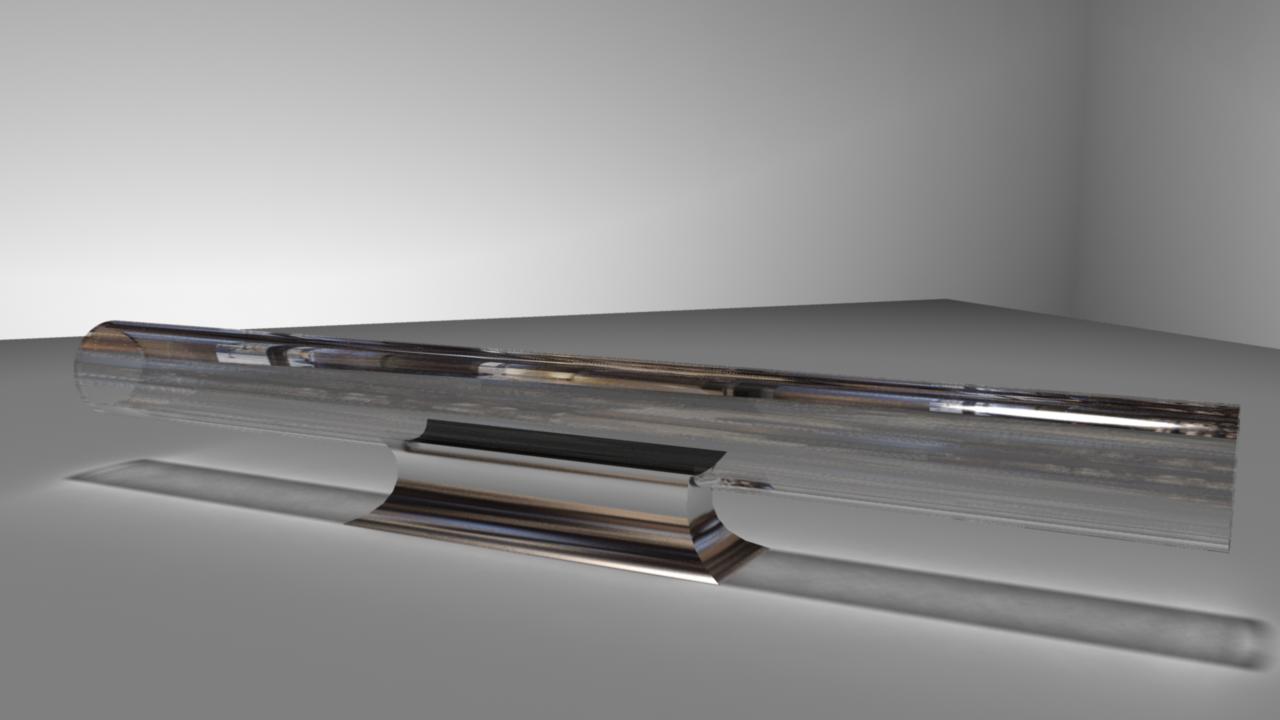
Not really knowing what to do next, I searched for machinists in the Bay Area. I emailed a few shops, explaining what I wanted but that I didn’t know much about fabricating metal…basically I was hoping to find someone who could help me through the process and have some patience as I learned what I was doing. I got only one gruff response from a place in Berkeley suggesting that my design was very complicated and would be very expensive, and recommending I come up with something simpler.
I didn’t really understand what about my designs were super-complicated; the first one in particular seemed so straightforward that it was almost boring. I emailed out at work asking if anyone knew anything about doing this.
This is how I met Drew.
“What are you trying to machine?” he originally responded, simply and directly. I emailed him my renderings and explained what I’d run into. “Why don’t you come down to my office, it’ll be easier to talk about this in person.” he suggested.
Drew used to be a machinist before coming to work at our studio. He’s a big guy with rough hands that have been stained of something every time I’ve been around him. Most offices in a visual effects studio are stacked with books with titles like “Programming Mental Ray 3.1” or “Fluid Dynamics, by Robert Bridson”. Drew’s office was littered with machine parts, metal bits and bobs, and wood scraps. I immediately liked him.
He explained to me that the thing that made my first design difficult was the tapered sides. Machining tends to work most-easily at right angles; tapered sides get into fixturing problems that suck up a lot of conceptual time. He explained to me how one would make the cuts that were needed to yield the shapes I’d designed, which highlighted for me exactly what design choices were ‘expensive’. I was fascinated.
“It’s unlikely you’ll convince a machine shop to do this for you. It would take them more time to set up their tools and rigs to get the angles right than it would for them to actually make the cuts. And, because you’re not ordering 500 of these, they can’t realize any economies of scale with you. Also, stainless steel is a huge pain in the ass to work with; you have to go real slow because the metal is so hard, and if you try to move too quickly the heat will harden the steel, which makes it unworkable and will wreck your machinery. Maybe you wanna think about starting with an easier metal.”
It was becoming clear that I’d be making these myself.
By this point, the Christmas holidays were hurtling towards us. I’d picked up my glass tubes from Adams & Chittenden, and they were great. Sarah was working a bit of last-minute overtime in the days leading up to our holiday break, so I took the opportunity to try to learn a bit more about how one machines metal.

I jumped into a last-minute Milling Machine class, a 3-hour crash-course introducing me to one of the main machines I’d need to learn to make these things, at San Francisco’s downtown TechShop. TechShop is a completely-badass idea in theory; it’s a huge workshop filled with every kind of “make something cool” machine conceivable. There are machinery mills and lathes, woodworking tools, CNC routers, bead blasters, vinyl printers, welding stations…it’s seriously awesome. The barrier to entry, however, is a $90 class one must take to be ‘checked out’ on a machine before one can use it. These classes are short and basically just run you through the fundamentals of turning the machine on and off and how to keep from getting killed using it. The Milling class I took was eye-opening insofar as I understood better what was involved in cutting a piece of metal and generally how the machine worked, but there was little context, and I walked away knowing only that I’d need to take more classes to get checked out on more machine AND would need to hire one of TechShop’s “Dream Coaches” to help guide me through the fabrication process to actually make my part. It was daunting and not very affordable.

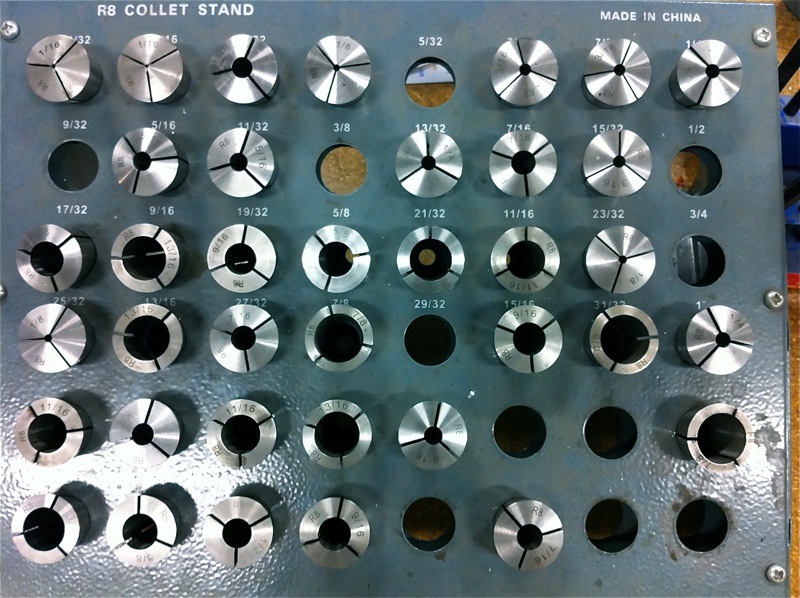
A good thing about the class though was having a better understanding of how to design for the machinery I’d be using. This part was exciting for me; understanding how one maneuvered metal around these machines made Crucial Detail’s steel service pieces even more interesting to me. I could clearly and easily see how they weren’t just arbitrary shapes anymore, had been designed with an eye towards manufacturing efficiency. I went back to my 3d software to work on some new designs.
Drew had pointed me to a good resource for sourcing raw metal stock; the aptly-named onlinemetals.com. Taking a look through the stock shapes they offered of stainless steel, the round tubes and bars caught my eye. I liked the idea of echoing the cylindrical glass tube’s shape in the pedestal design, so I played around with ways of cutting tubes/rounds:
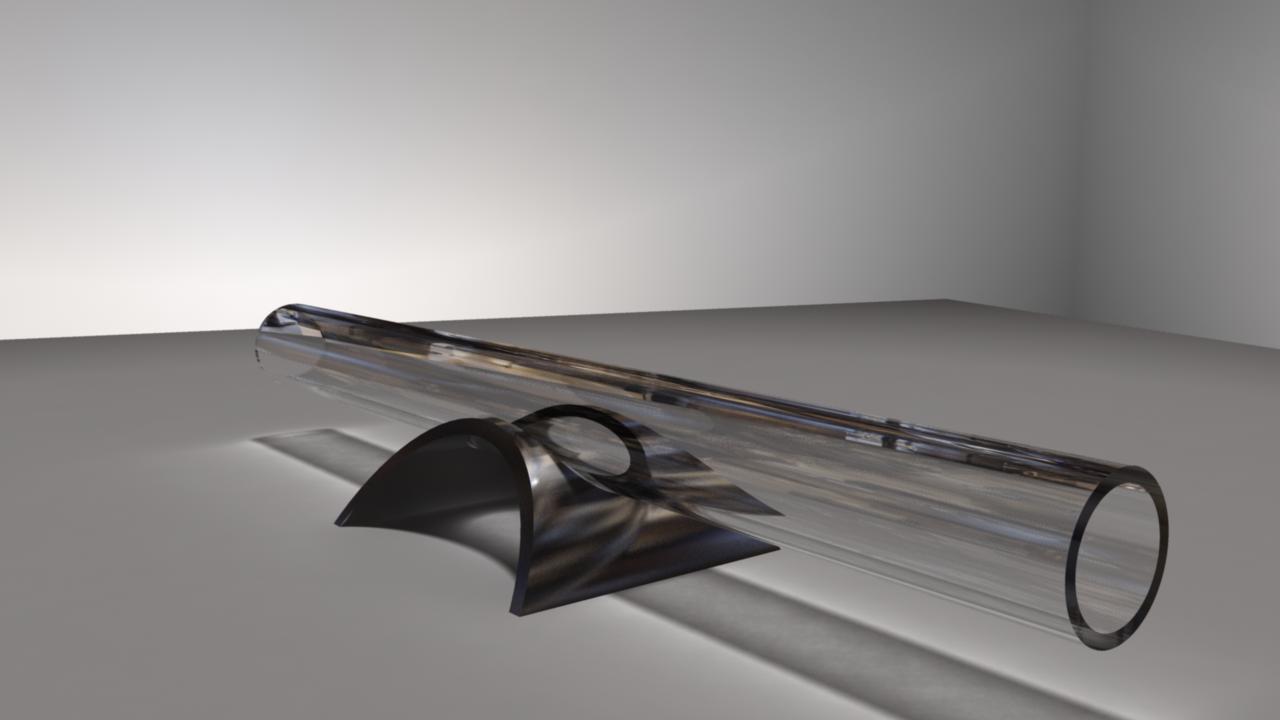
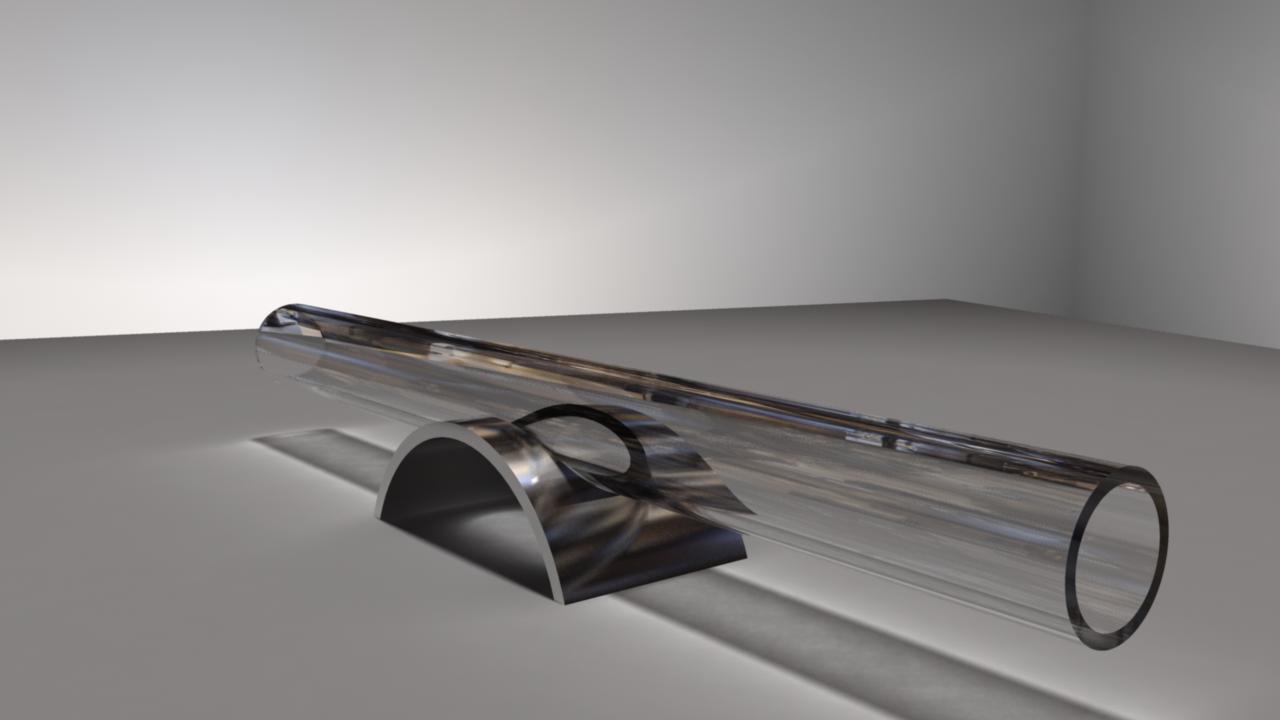
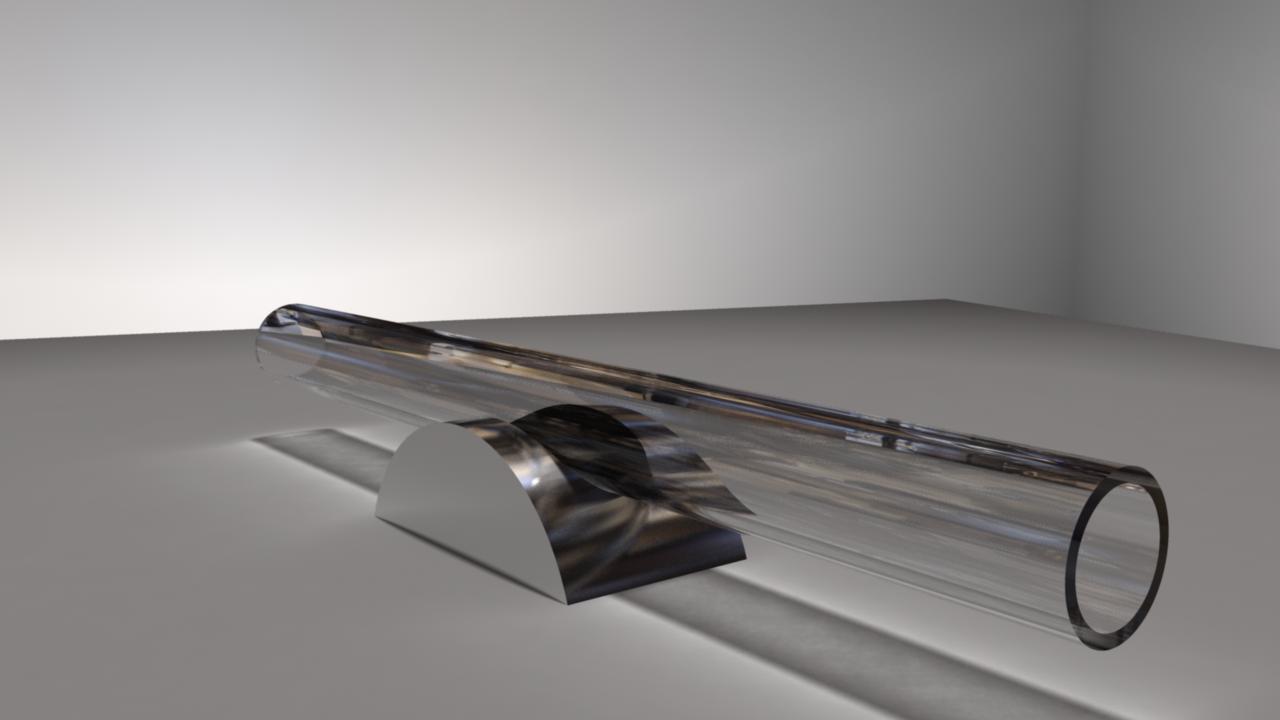
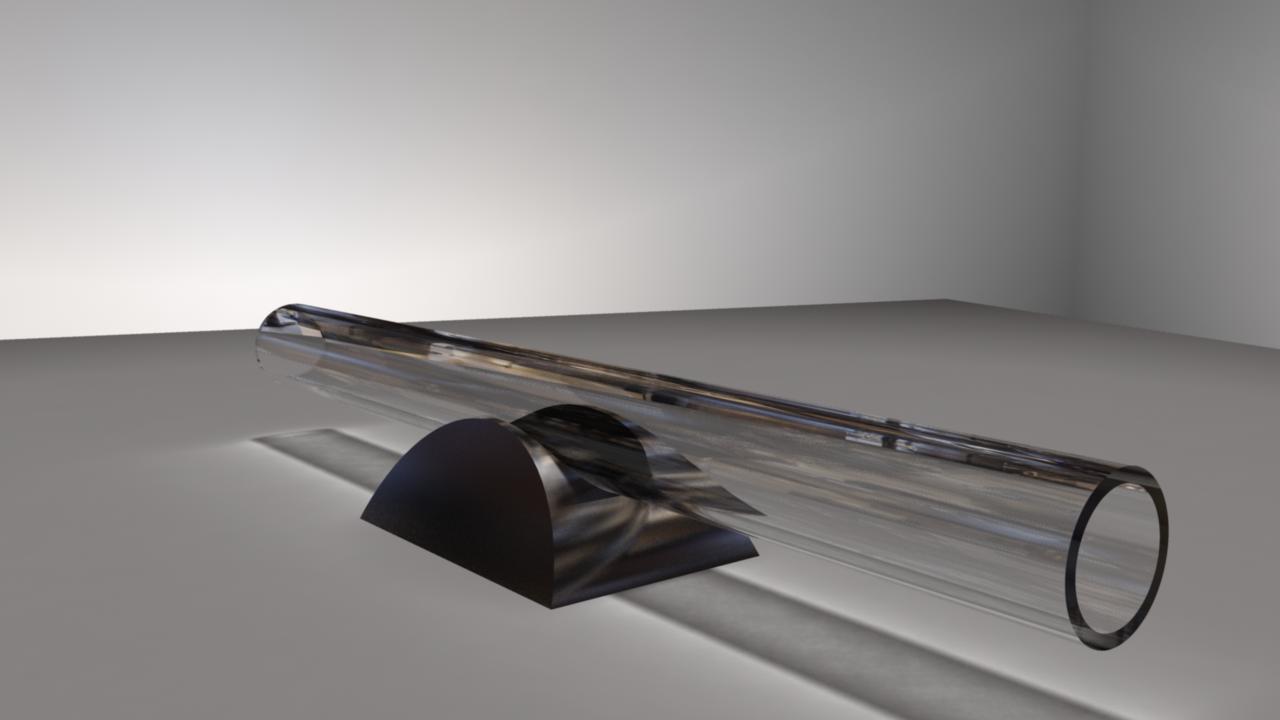
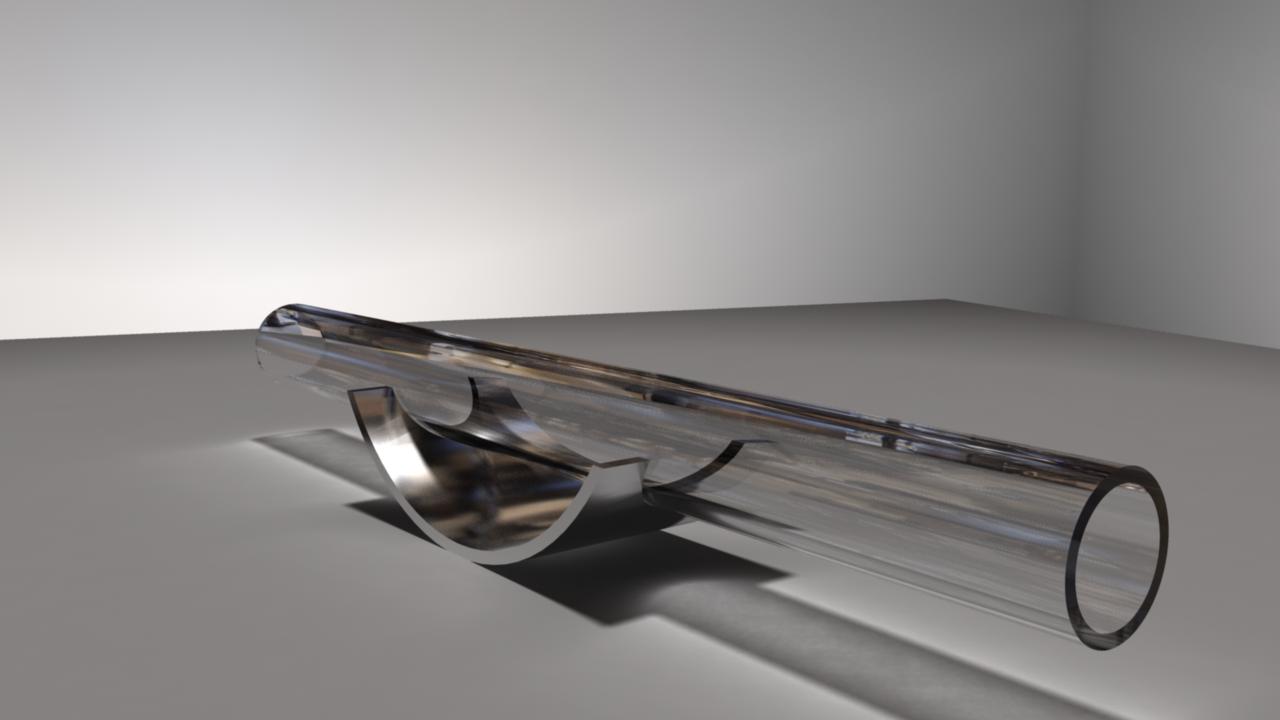
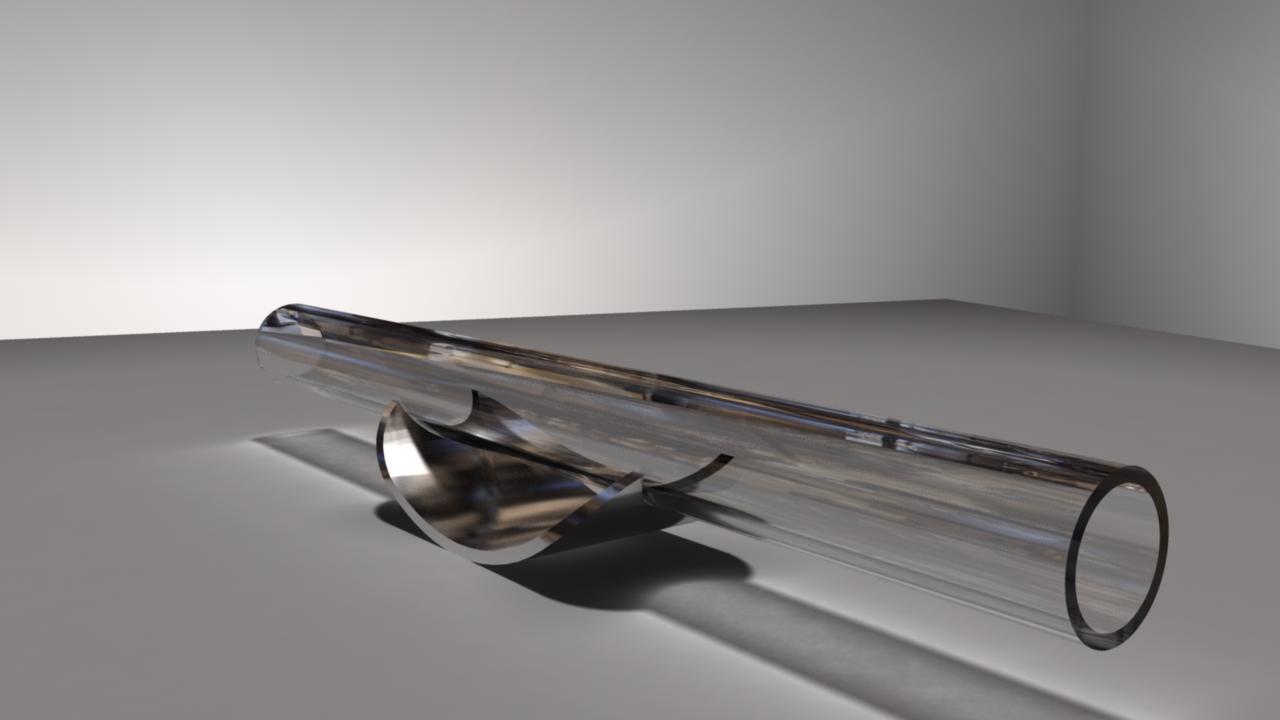
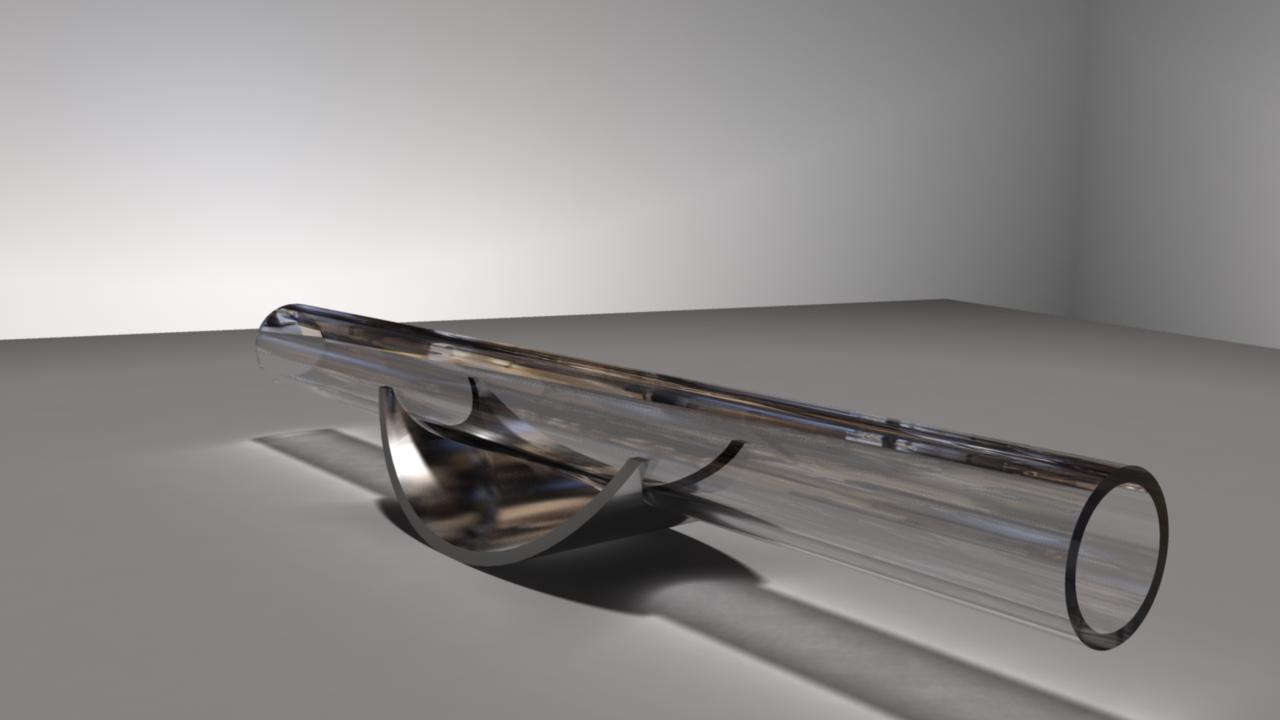
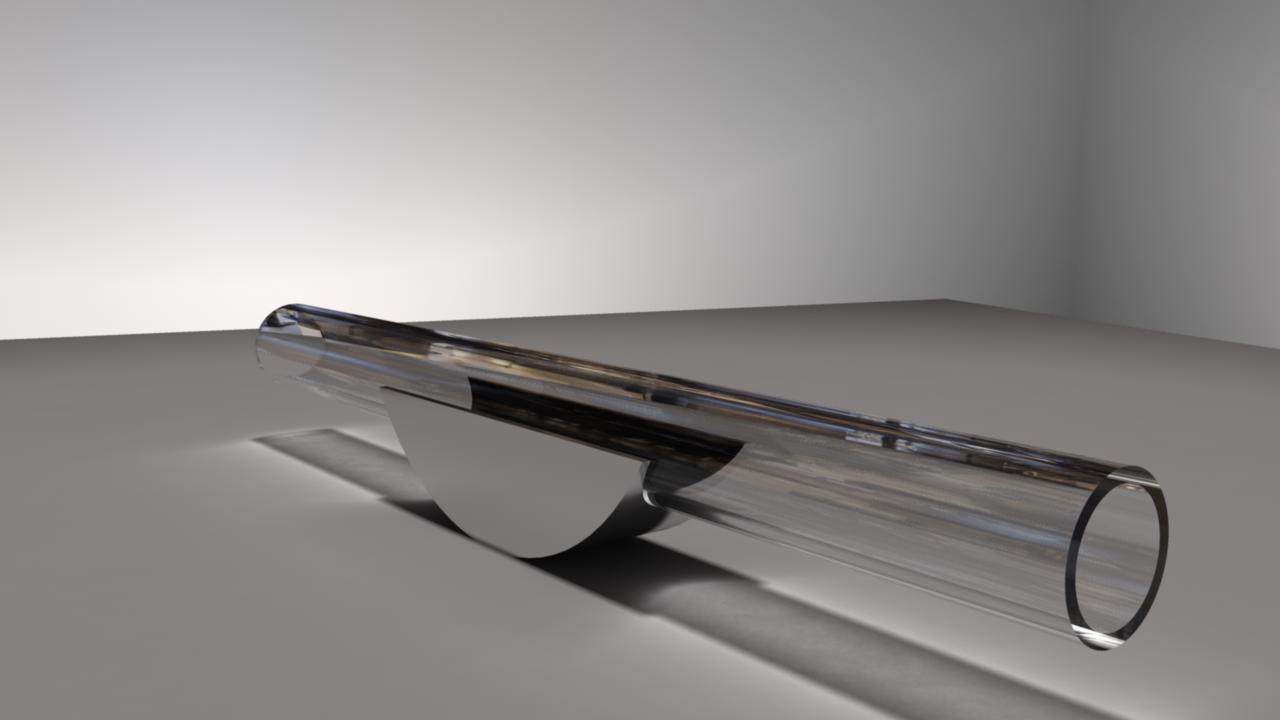
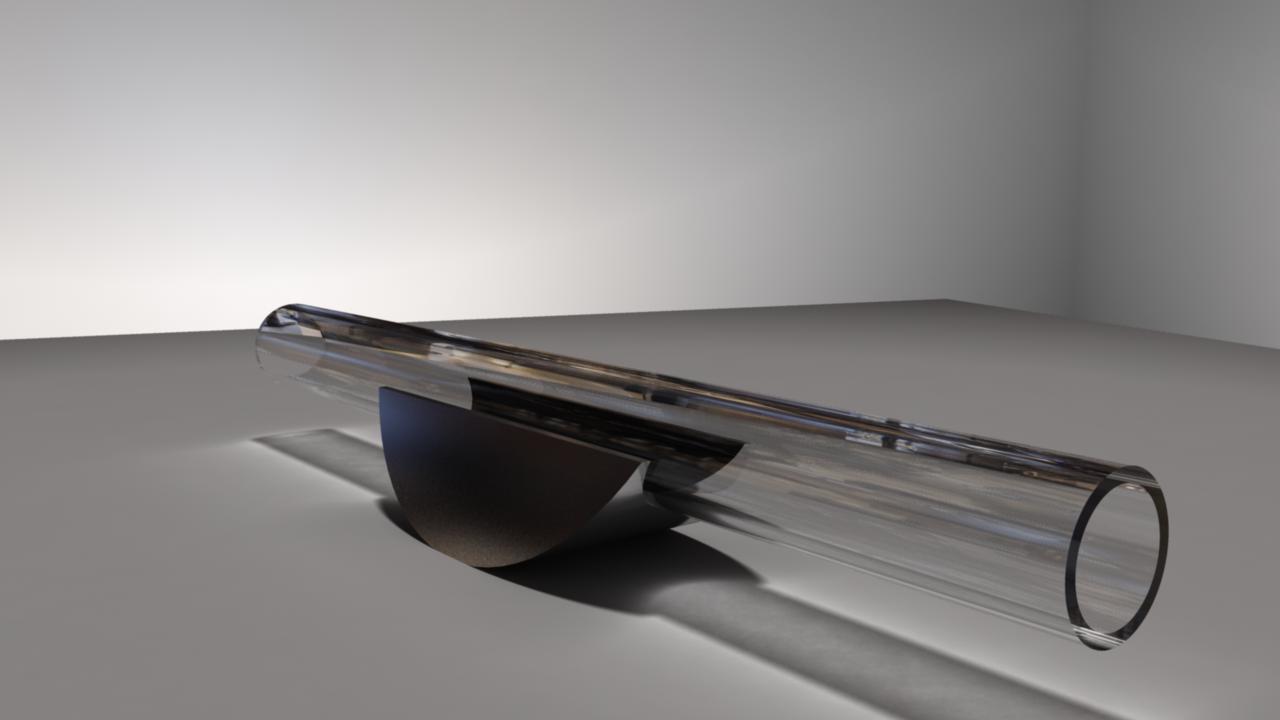
The “upside down” ones came from a further idea I had about playing with balance (loading one end of the tube with a denser ingredient and setting it off-center in the pedestal might look interesting). Drew reminded me that tapered sides were difficult, and to avoid introducing too many variables at once, I chose one of the simpler designs to carry through the fabrication process:

With Drew’s guidance, I fleshed out a “spec” for my design. This just meant identifying measurements and tolerances that I cared about, that would guide a machinist through the final desired dimensions. Being used to Alinea’s use of the metric system, I continued through with that here; ultimately I found metric machining tools to be tricky to find, so I deferred to imperial approximations once I got going.
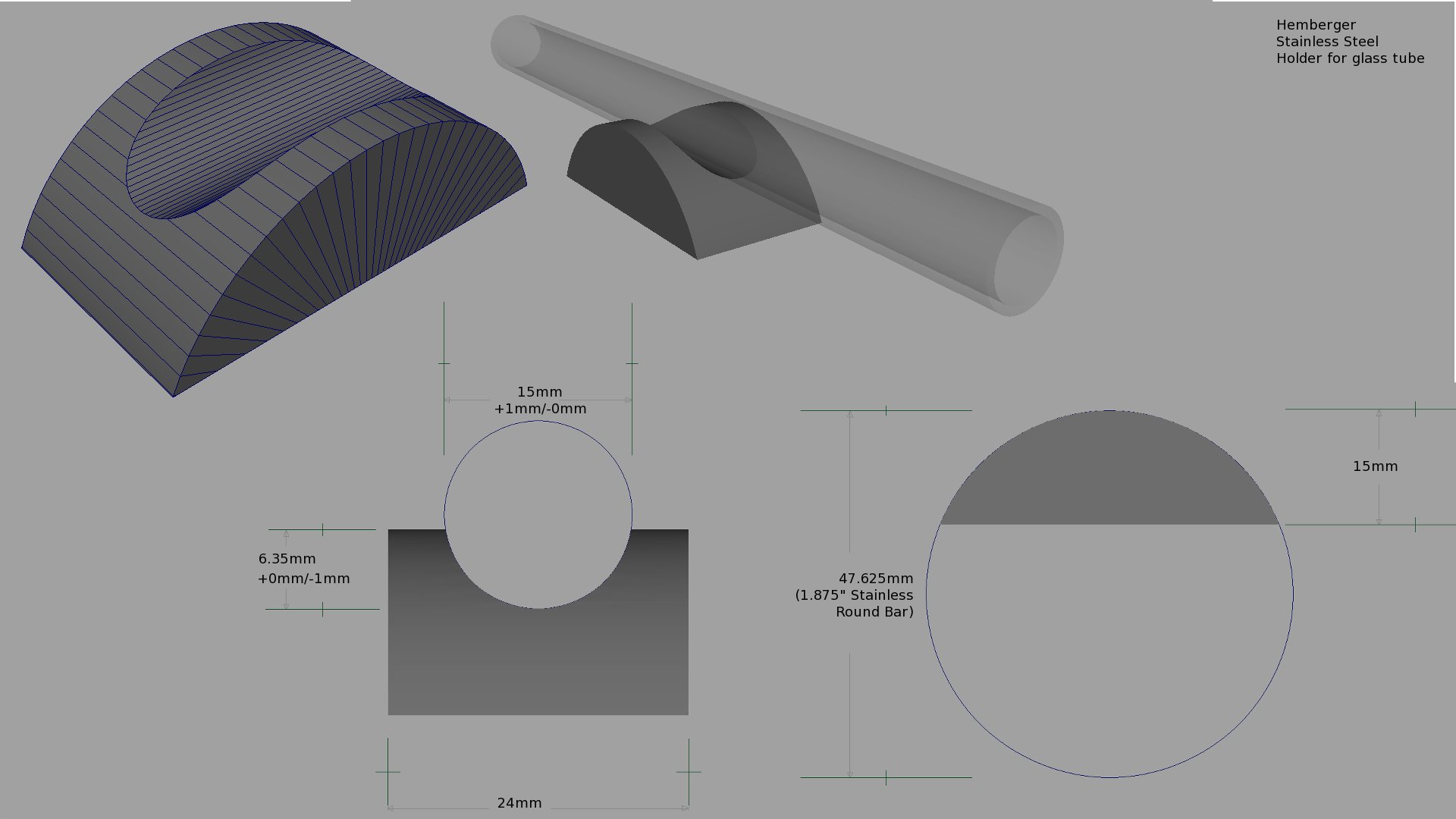
My next step was ordering some stock and the proper tools with which to do the machining. I ordered 12″-long pieces of 1.875″-diameter 303 Stainless Steel, as well as the same size of aluminium for prototyping. When they showed up a few days later, I was struck by how heavy both rounds were, especially the stainless, which weighed around 8 lbs.
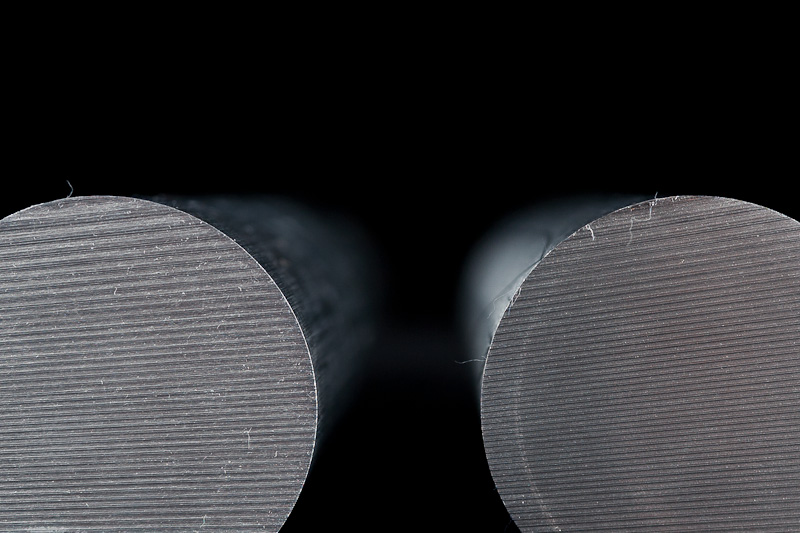
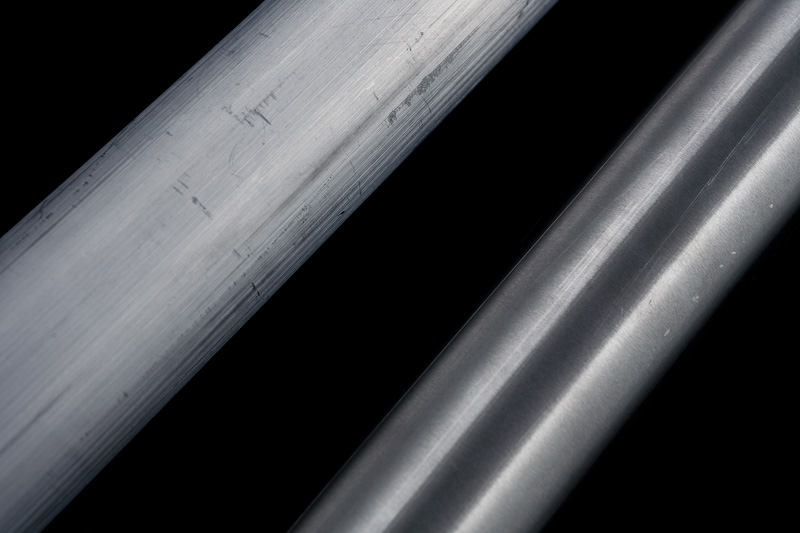
Milling machines are sort of like giant dill presses–there’s a downward-pointing vertical motor-driven spindle into which can fit any number of cutting mechanisms. This cutting bit (called an “End Mill”) spins while the machinist moves the part around under it, passing it past the cutter using one of three moving axes. A digital gauge allows for incredibly-precise incremental movements of this 3-axis workbench; one can make cuts that are accurate to 1/1000 of an inch.
Because I was working with a very hard metal, I knew I’d need some high-performance end mills with which to work. I bought a 1″-diameter 4-flute carbide end mill, and a 0.5″ 4-flute ball-end carbide end mill. The former would be use to ‘face’ (ensure complete flatness) of my straight surfaces; the latter has a rounded cutting tip and would be what I’d use to cut the channel into which my tube would sit.
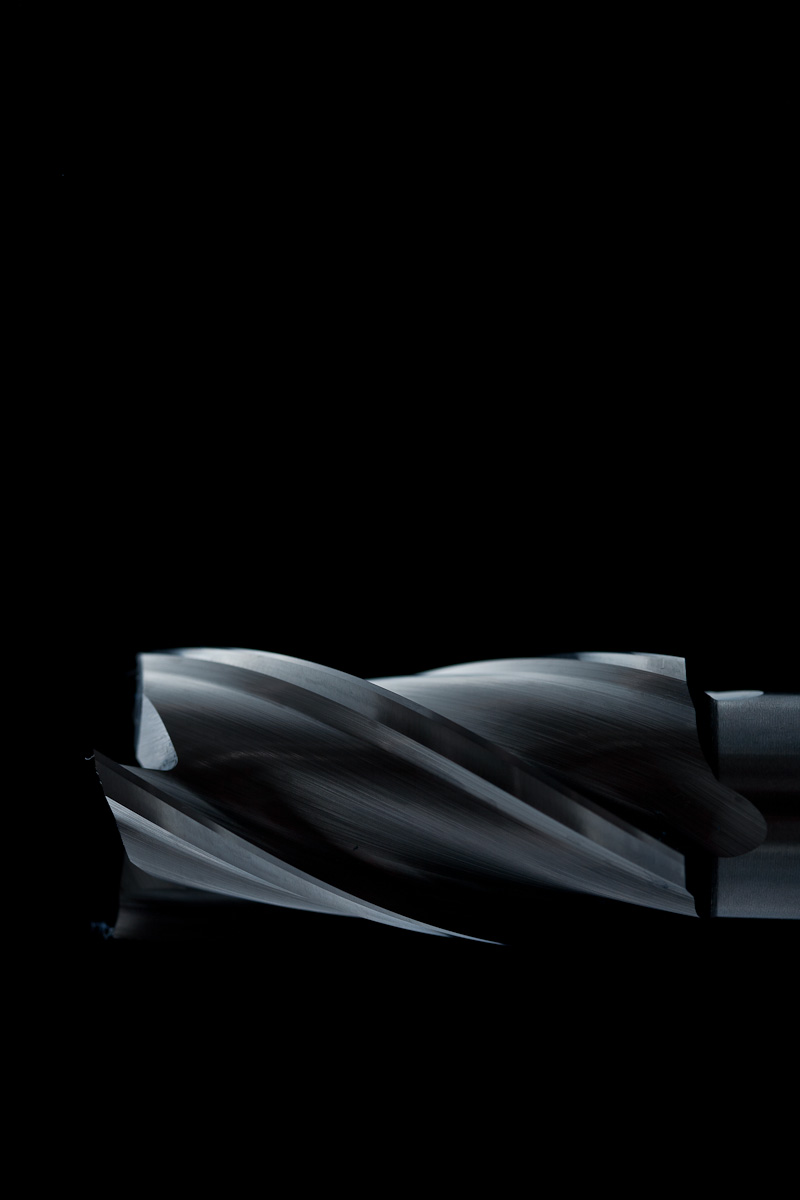


For the actual fabrication, Drew graciously offered to help. He has all his machinist’s equipment set up in a workshop on his property, so one weekend I packed up my gear and headed to his place for some tutelage.
The first step in fabricating this was to cut off a disc from the stainless steel round (“slabbing it off”, Drew called it). We did this using a horizontal band saw, which uses gravity to pull the blade down through the piece being cut. I was aiming for a final width of 1″, so we cut slabs about 1/8″ wider than that to allow for facing the slab (to ensure both sides were flat and parallel).
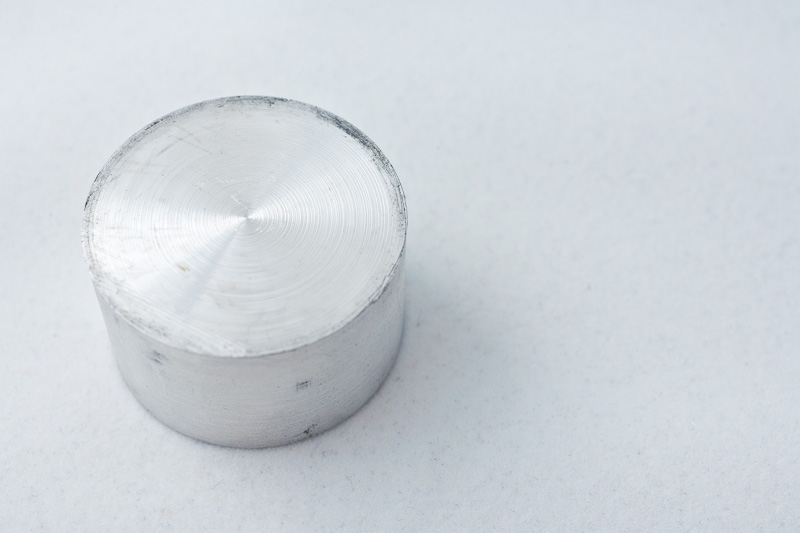
(This is a piece of aluminium I was using for prototyping purposes)
I then faced the slabs on a lathe to my final width of 1″, going as slowly as I could to ensure as smooth a finish as possible (knowing that any tool marks I left on the steel would have to be sanded out later, which I suspected wouldn’t be super-happy fun times). After facing the slabs, I drilled two holes in each slab, so that I could bolt the slabs to a bit of square aluminium (which would make the next step of holding the slab in a vice a bit more stable). These slabs were then cut with the bandsaw again on either side of the bolts, to yield two half-moon shapes.
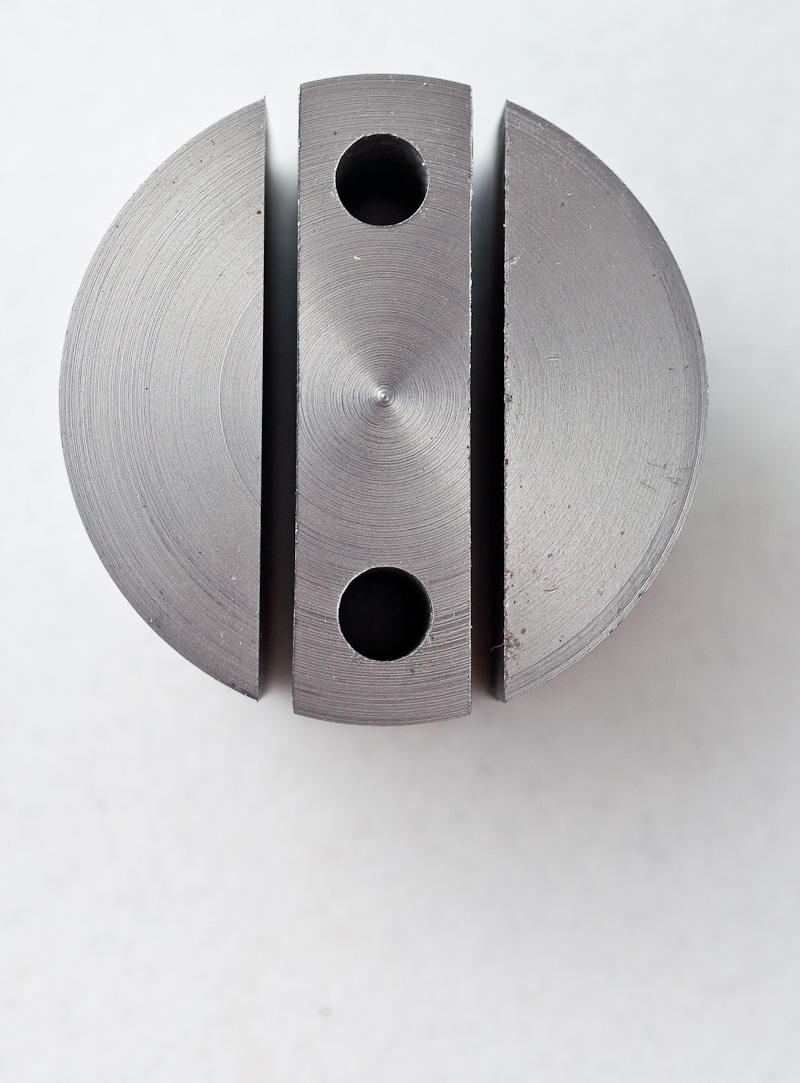
I used my 1″ end mill to face the just-cut sides of the half-moons, to ensure they were flat and all of uniform size, again going as slowly as I could to minimize tool marks.
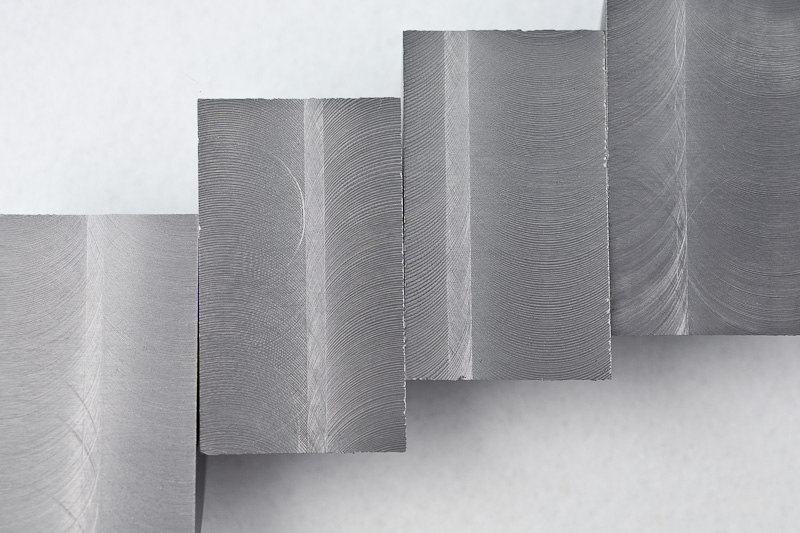
The last step was flipping over the parts and using my ball end mill to cut a groove that would cradle the glass tube.
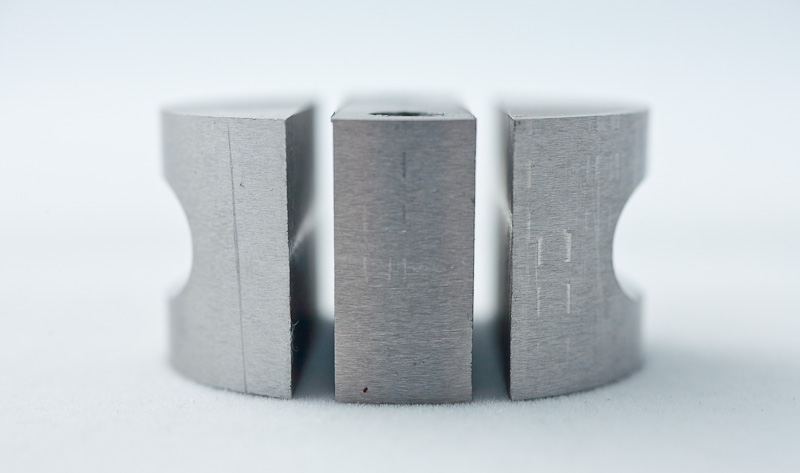
Sarah joined me for the day, armed with her camera:
The whole process took about 8 hours, and at the end of the day I had 10 completed pieces to take home. I was completely ecstatic; the amount of precision involved in getting them all to be exactly the same was so fascinating and satisfying to my OCD tendencies. But I knew I wasn’t done; the parts looked nice but had tool marks all over them, hard edges with burrs, and lots of other cosmetic flaws. They neither looked nor felt inviting, and that was the most important part of all of this to me; I wanted a piece that looked beautiful and invited one to touch and feel it, to pick it up and inspect it. These looked sharp and a little dangerous.


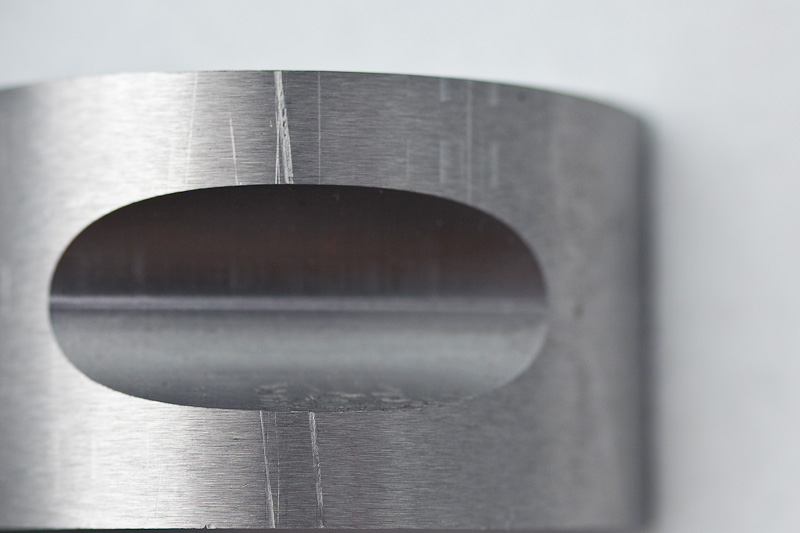
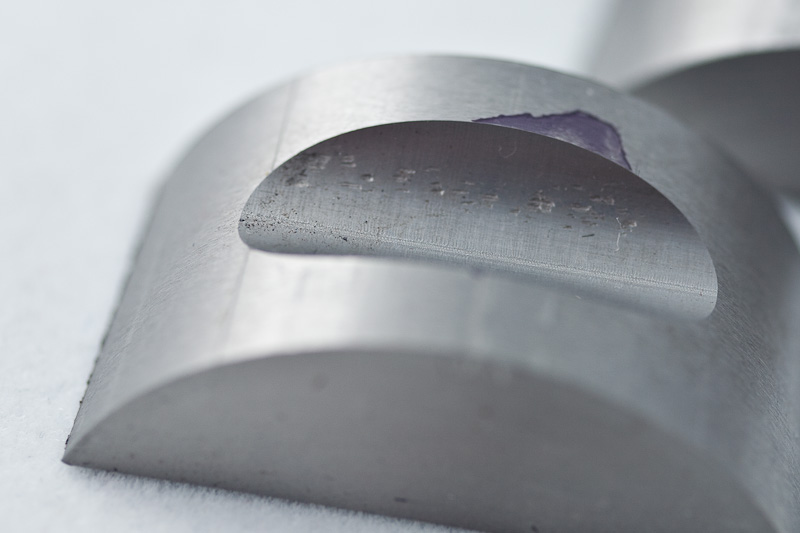
I bought a random orbital sander and several packs of sandpaper in various grits. The first (and most arduous) step was getting rid of all tool marks on the pieces. This was most difficult on the bottoms of the pieces, where the end milling had left deep circular gashes. I started with 80 grit and slowly, slowly, slowly started stepping up through the entire grit range. After 8 hours of sanding, I was halfway done. I’d made it up to 220 grit and the parts had started taking on a satiny texture and a very smooth, silky feel.
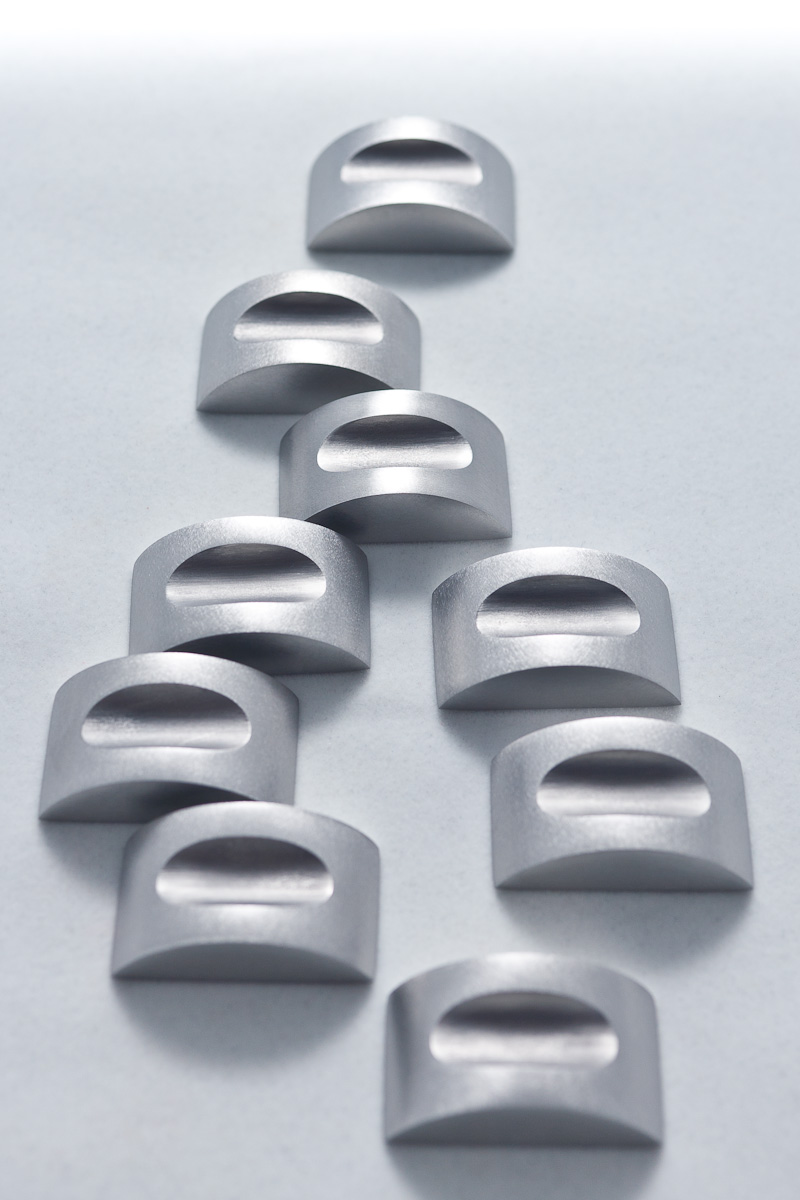
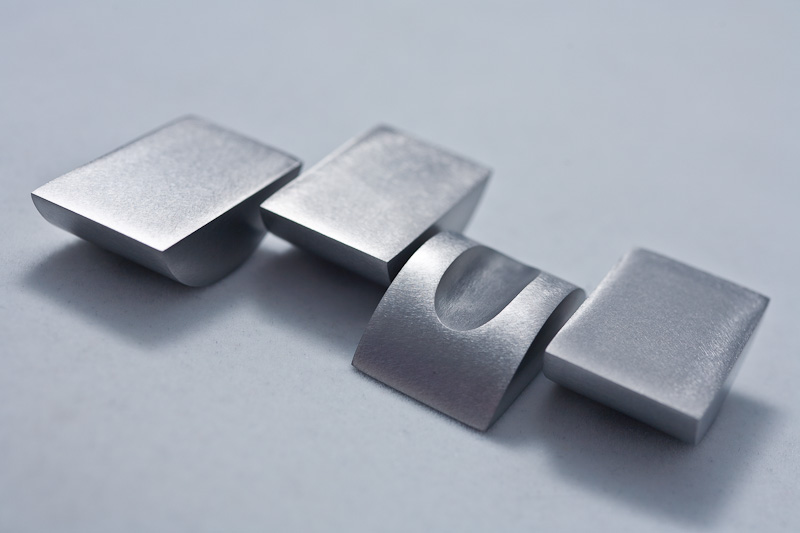

The next day, I pressed on for another 8 hours or so, stepping up to a final grit of 600. I worried the difference would be too subtle to notice, but when I compared a piece finished to 600 grit to one finished to 220 grit, it was night and day:
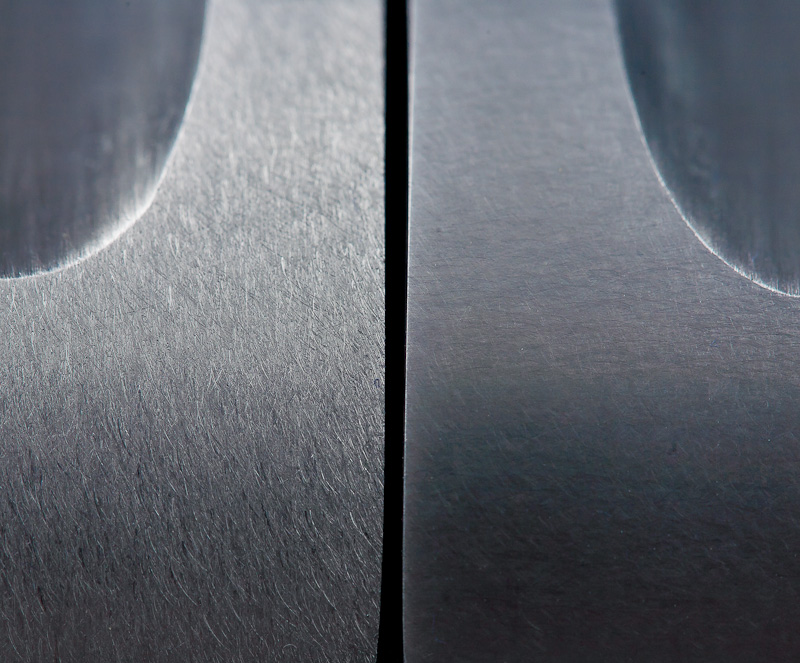
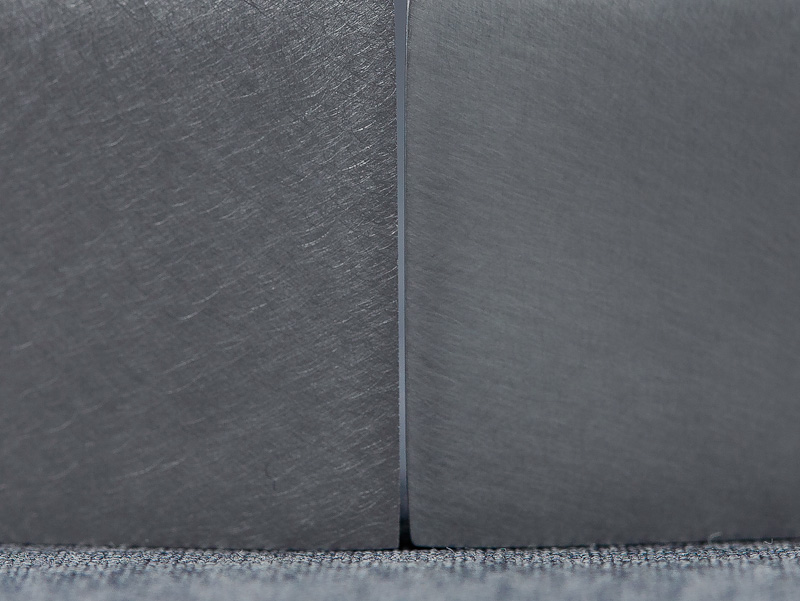
I used some sandpaper wrapped around a Sharpie to brush out the interior grooves. Though they were a little coarser-finished than I would have liked, the grooves caught light in an interesting way that makes them look contrastingly-different depending on how the light hits them; I thought this effect was neat.

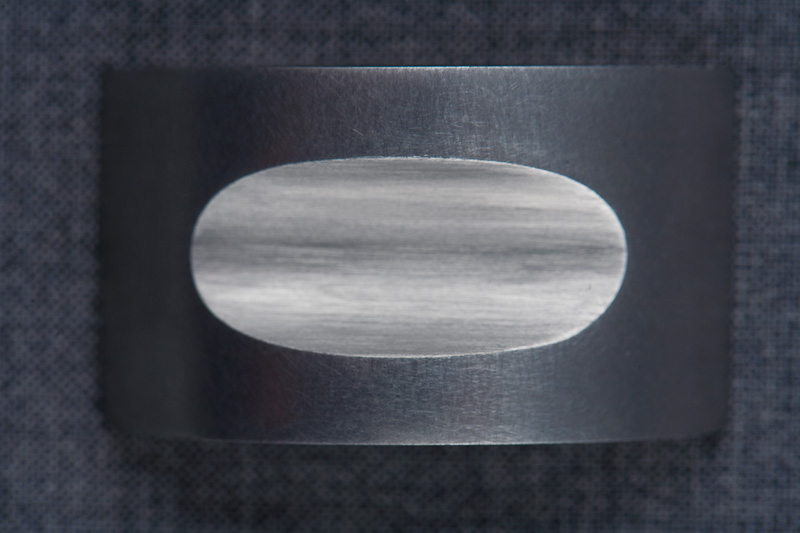


At the final 600 grit, I also ‘kissed’ the edges of the part gently, to put a tiny, tiny bevel on them so they wouldn’t feel quite so jagged to the touch, but still looked sharp and precisely-angular. There was also a little visual benefit; the tiny bevel causes the part to catch light on the edges, which in turn makes it look more sharp and precise. You can see in the previous photos the lack of this edge highlight.


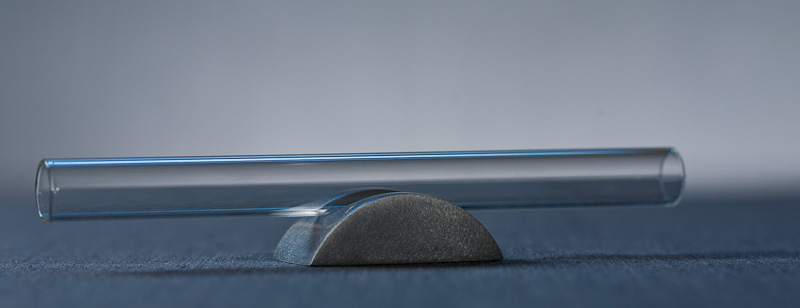

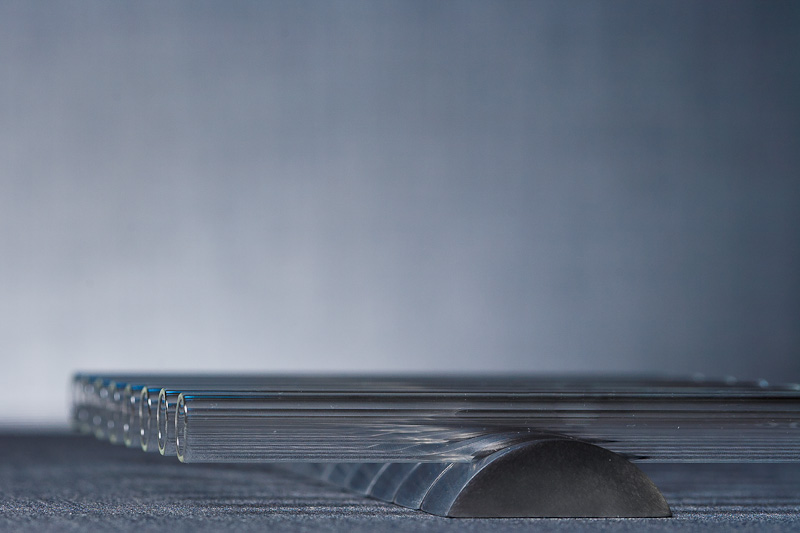


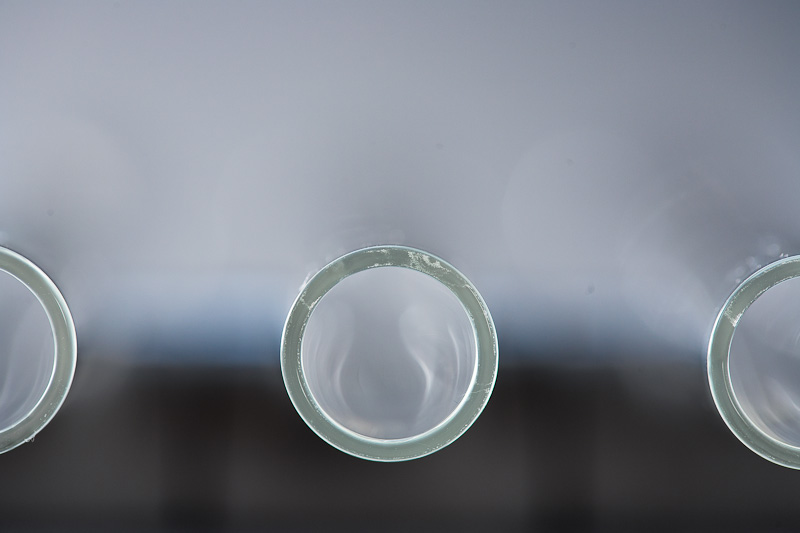
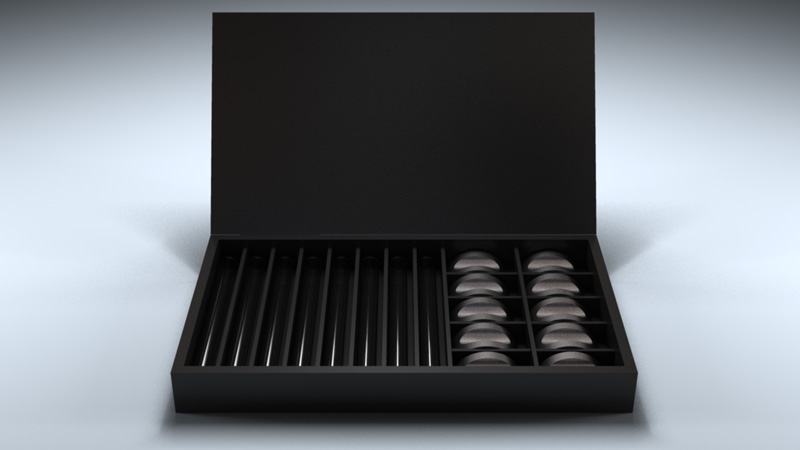
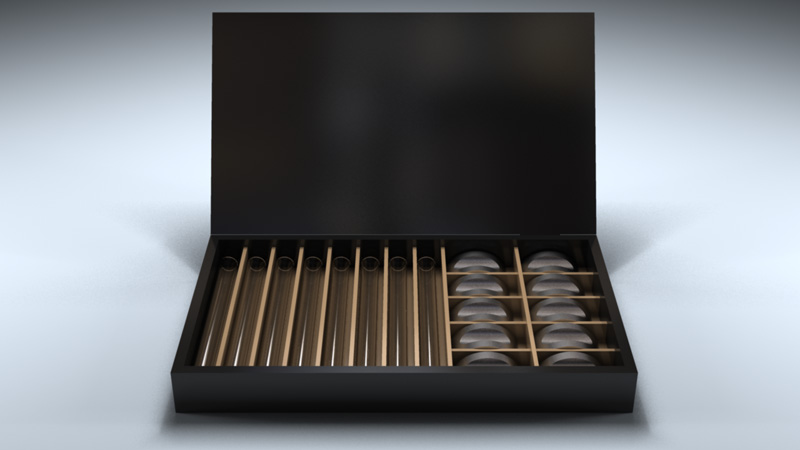
I exported the plans for my box as curves to Adobe Illustrator, then uploaded the files to Ponoko. The curves described cutting lines to be made by a laser cutter. These are exploded views to show how what the individual pieces look like and how they fit together.
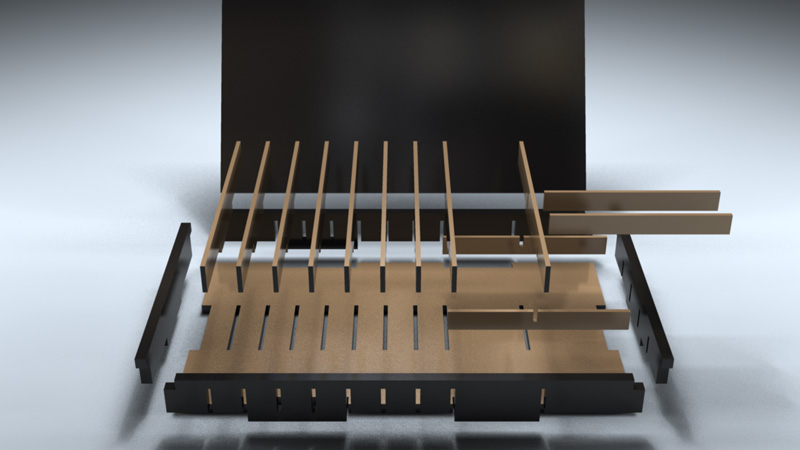
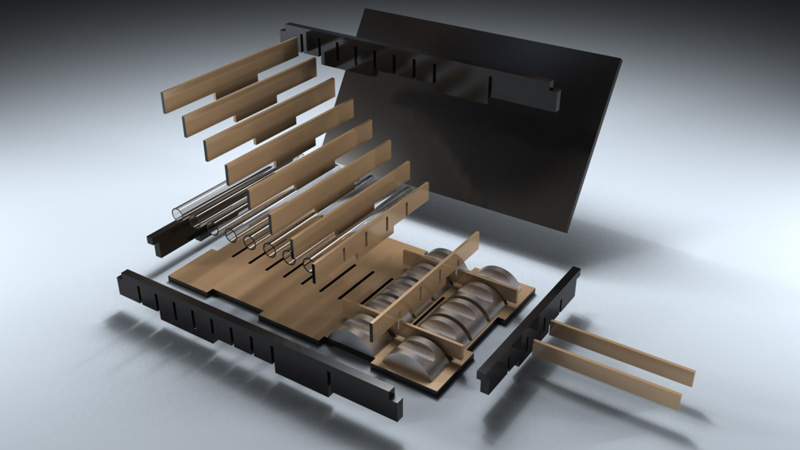
As of this writing I’m still waiting to get these parts back from Ponoko; I’ll include photos of the box in a later post once I’ve gotten it assembled.
A critical and tricky step to filling these tubes with food of any sort is that they need to stand vertically to be filled. The ends can be plugged with gelled flavors, but this requires they be stood in warm liquid and moved to a fridge to be allowed to cool. This seemed tricky and potentially-annoying to me, so I wanted to make another accessory to help make my life a little easier. I decided to make a foodsafe silicon mold with 8 holes in it, which would hold the tubes upright and steady while they were moved from one location to another. I did some searching for foodsafe silicon kits, and settled on one that seemed reasonably-priced from the aptly-named makeyourownmolds.com. What I got was a two-part pourable silicon mix that works a lot like a two-part epoxy: just mix in equal parts, pour, and let set.
I made a frame out of plexiglass held together with bulldog clips to serve as the ‘sides’ of my mold, and another piece of plexiglass was the bottom. I used clay to stick my tubes into place on the plexi, then weighed them from the top with a clay brick to help hold them firm and steady as I poured the silicon around them.
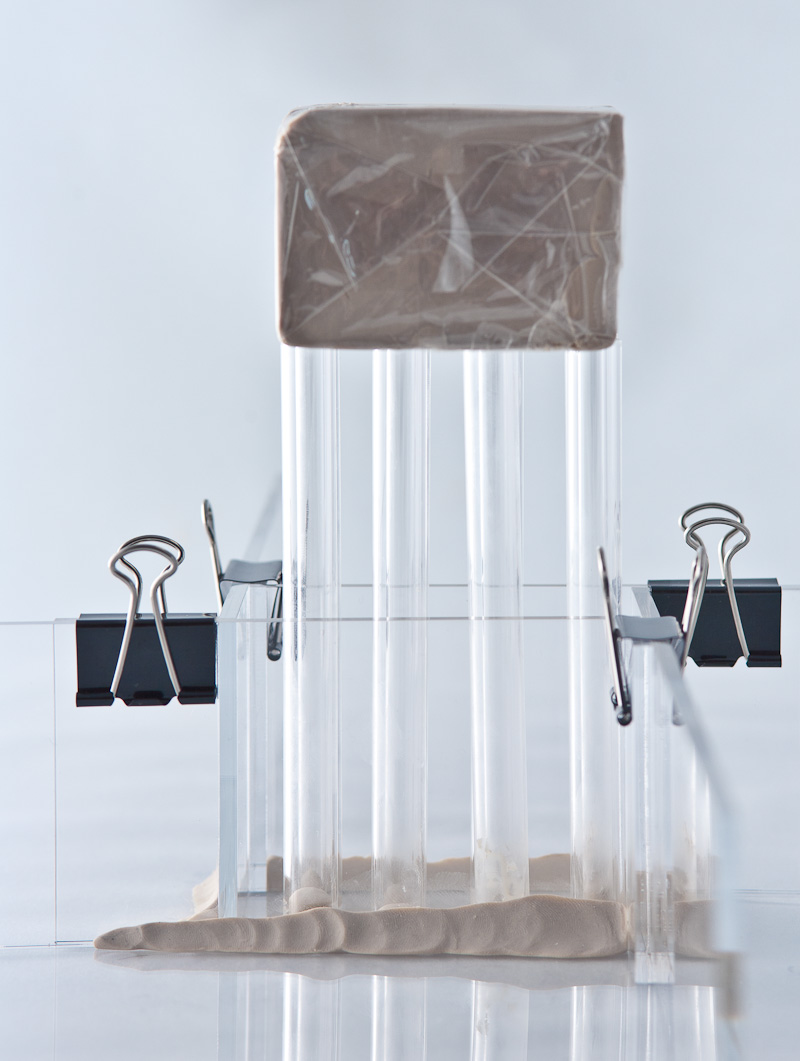
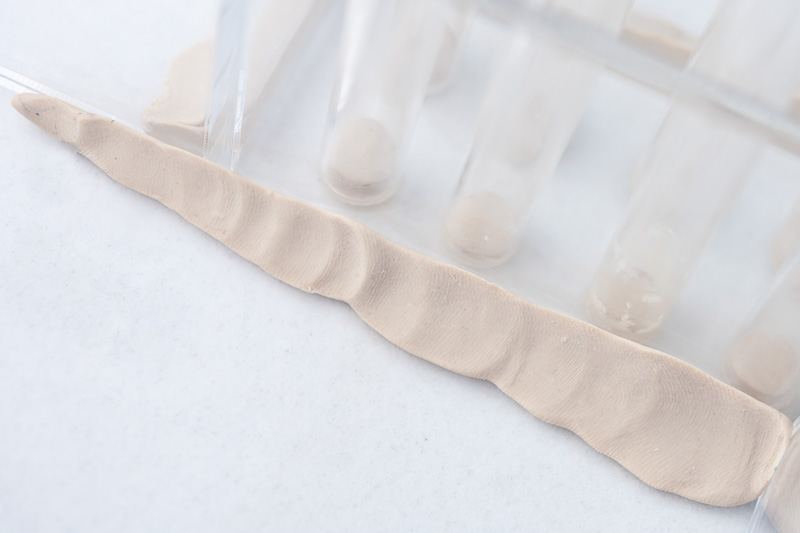
The silicon itself was easy to mix and pour; I used about a half-cup to fill the mold, then let it set for 4 hours, after which I could remove the tubes and outer casing and let cure overnight to completion.
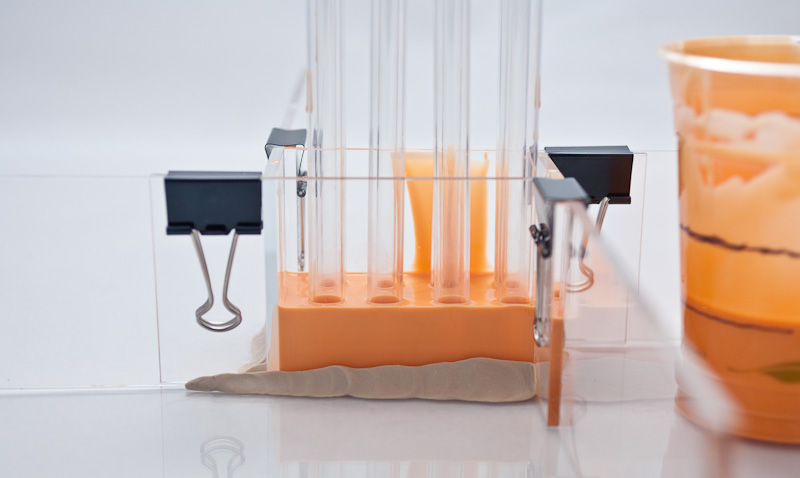

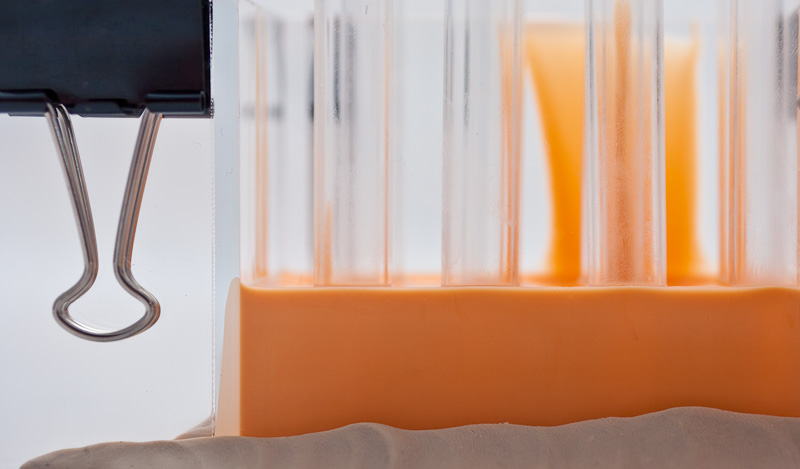
After making my servicepieces, storage box, and silicon holder, I wanted to actually make some food that used all these things. This dish draws obvious inspiration from (and is a clever interpretation of) asian “Bubble Teas”, which are usually flavored soda/tea with flavor-infused ‘bubbles’ in the bottom of the tea cup. They’re typically served with a large-diameter plastic straw, which is helpful for sucking up the ‘bubbles’, which are actually cooked tapioca pearls.
My first step was to make some bubblegum stock. I started looking for what I consider to be a pretty classic bubblegum:
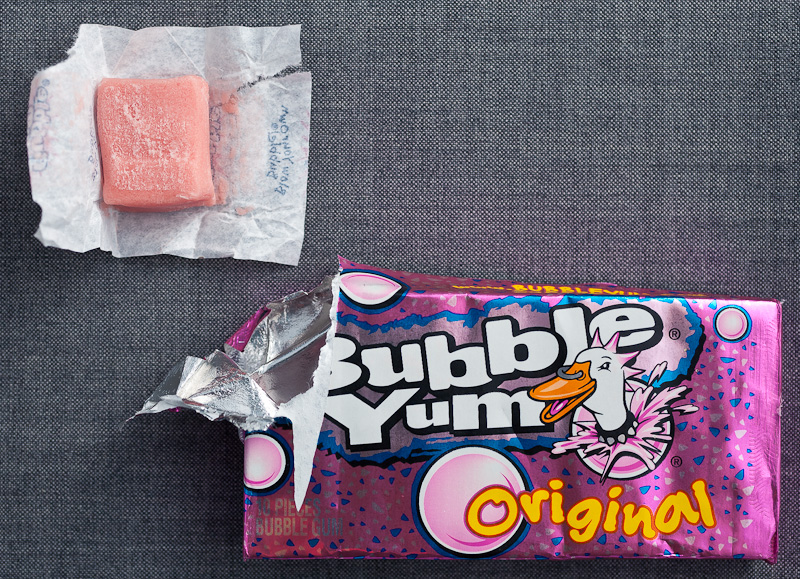
I found it hard to track down a large amount of this in bulk; Sarah reminded me of an even MORE classic gum that I could easily find in bags at places like Target.
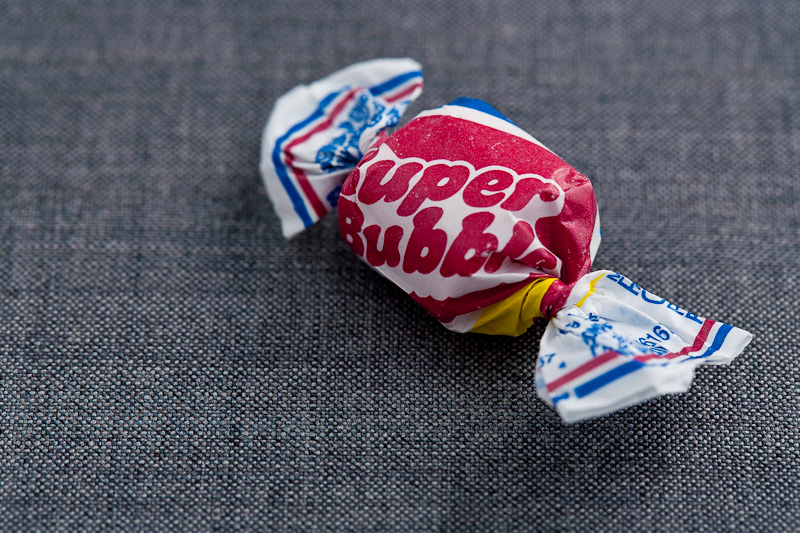
She was totally right; for about $3 I came home with 2 lbs of delicious bubble gum. I unwrapped it all, weighed it, and put it in a pot with an equal part water and 10% sugar (the sugar amount was just a guess). I cooked it until my kitchen smelled like bubblegum, laughing most of the time. This was seriously the funnest/funniest thing I’ve tried so far. After about 10-15 minutes of cooking, I had a pot full of water that tasted powerfully like bubble gum.
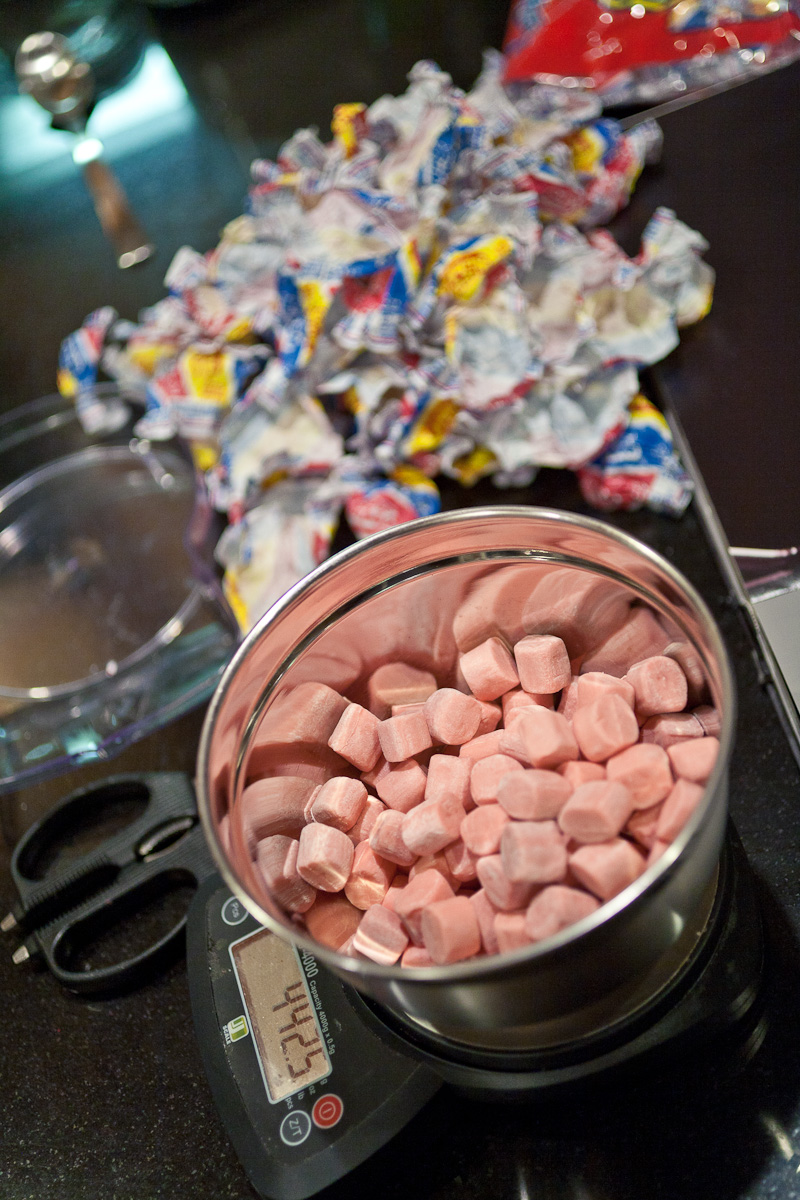

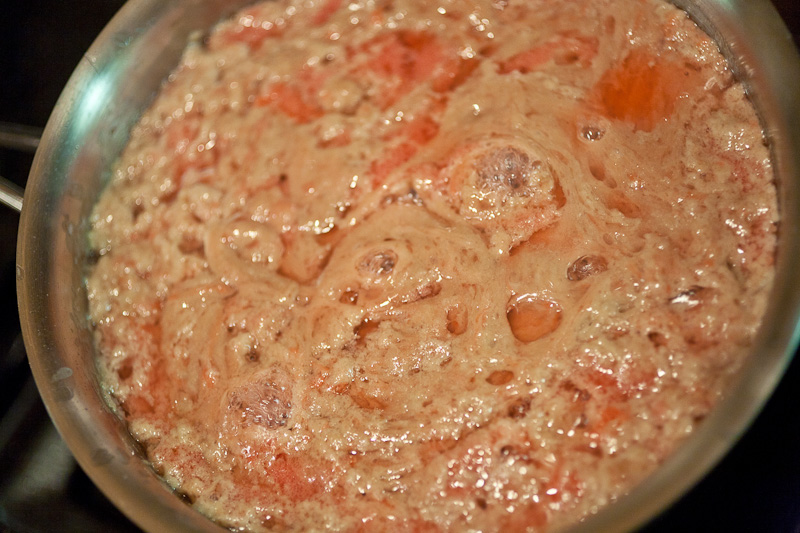
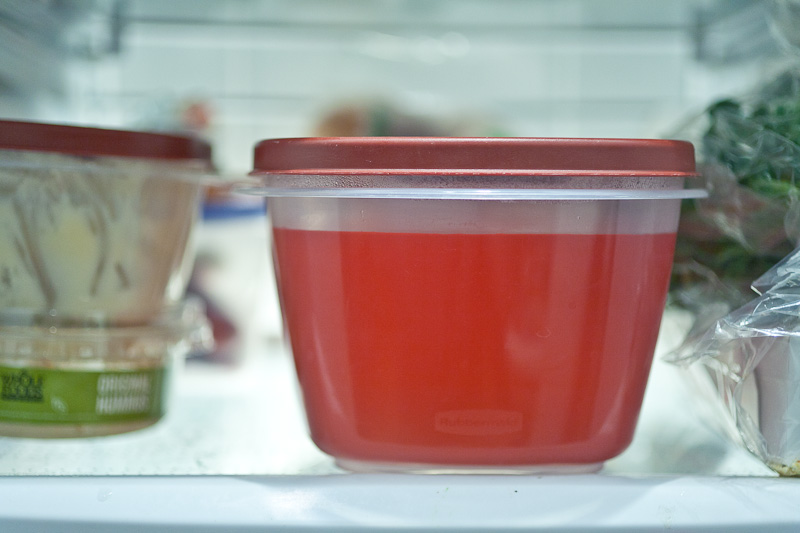
A side note: I wouldn’t wish the cleanup of this on my worst enemy. It was awful…but still hilarious to me.
Next, I needed to cook some tapioca pearls in the stock. This took me several tries to get right; large tapioca pearls are tricky to cook evenly throughout. Mine were either undercooked in the center (which made them reminiscent of undercooked pasta) or cooked through the center but a bit too gelatinous on the outer surface. What I finally ended up doing was letting them soak for several hours in warm stock, then pressure-cooking them for 45 minutes; this yielded something I was happy with.
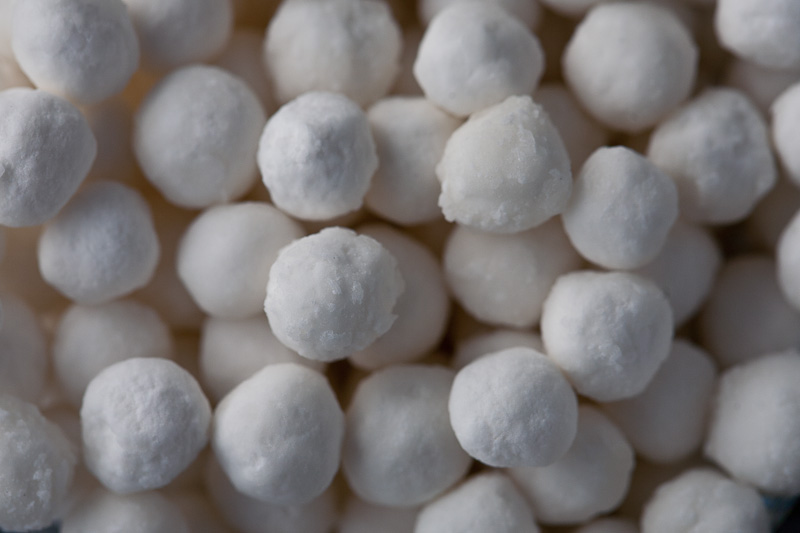
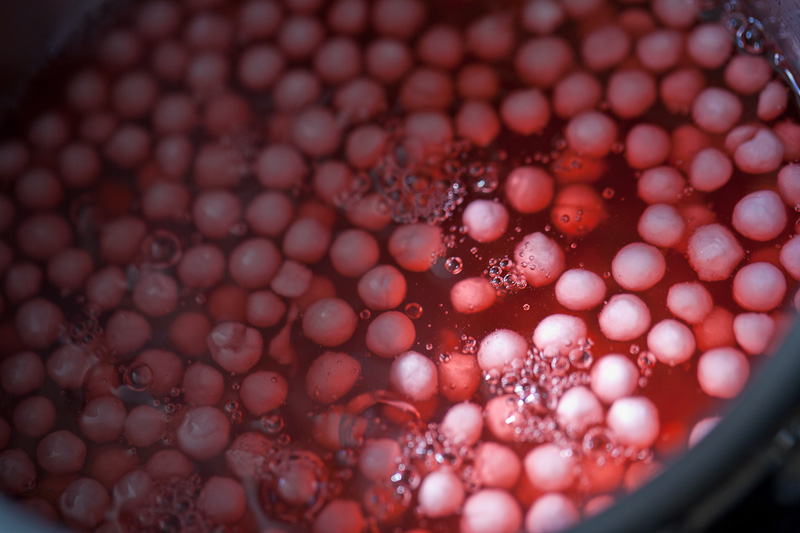
I heated the creme fraiche to just under a simmer with the seeds of some vanilla beans and some sugar, then stored that in a squeeze bottle in the fridge. For the hibiscus gel, I steeped some hibiscus flowers in hot water for about 20 minutes, strained, then warmed with gelatin and poured into a sheet tray to set. Lastly I made long pepper gel similarly, poured that into a small tray, and set my tubes vertically in the gel to let it set (I used my ‘tube mold’ to hold the group of 8 tubes upright as I moved them into and out of the fridge).
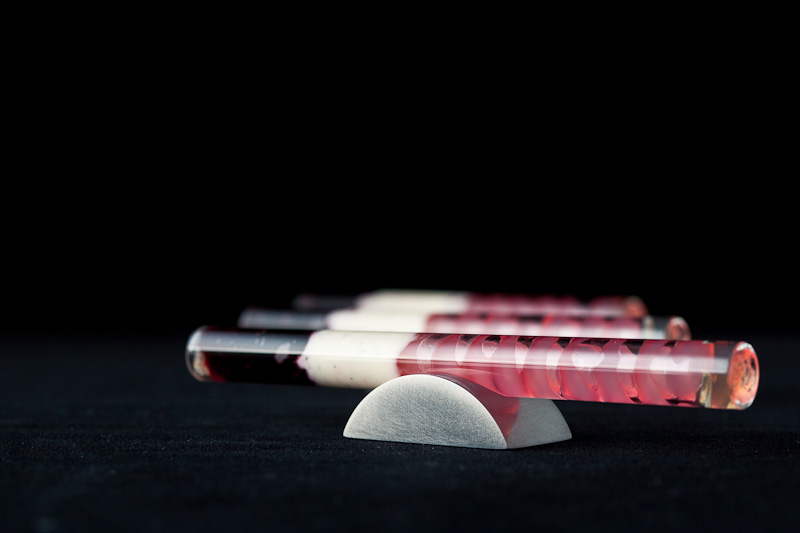
The tubes are loaded bottom-to-top with several bubblegum pearls, the creme fraiche, and finally the hibiscus gel (which I picked at with a spoon until it had the consistency of store-bought jelly before loading it into the tube). Because one end of the tube is sealed and all the ingredients are wet, once they’re loaded into the tube they tend to stay firmly in place from suction. This made plating and serving them extremely straightforward.
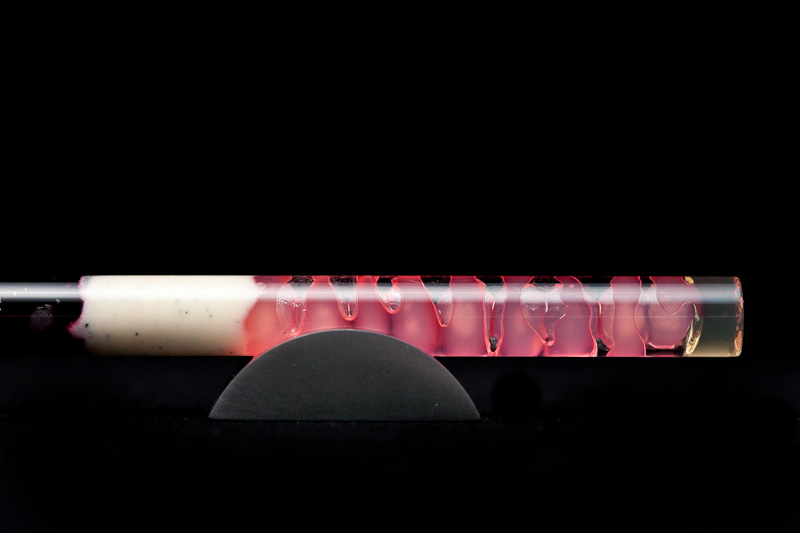
Finally, finally, finally, after all this, Sarah and I sat down to taste one. Honestly I was a terrified; even though I’d been very careful to taste as I went, checking everything along the way, after this much effort anything less than awesome would bum me out.
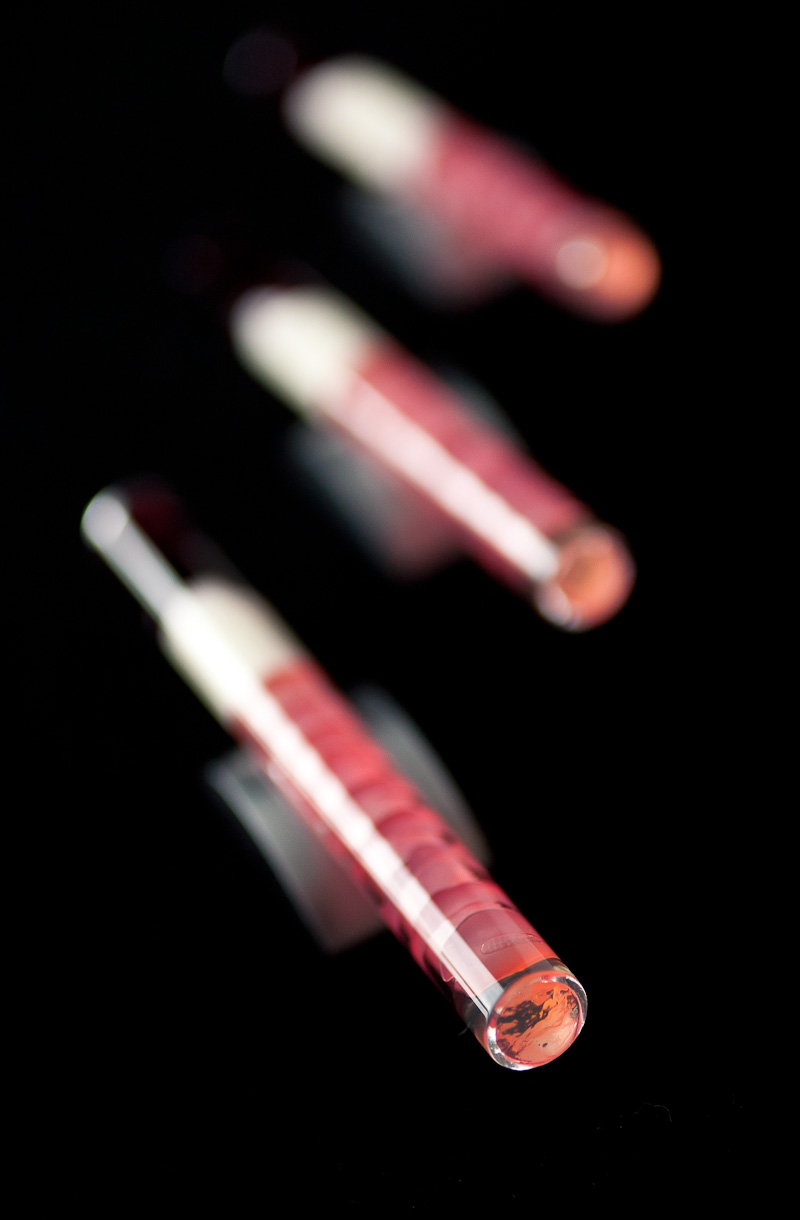
Awesomely enough though, it was awesome.
Even better than awesome, in fact! It was exactly perfect for me; it tasted exactly as I remembered it tasting at Alinea. Not cloyingly sweet, very well-balanced, and startling in the flavor progression. The tart, bright acidity of the hibiscus is the first thing I tasted, which gave way seamlessly to the creme fraiche, its subtle sourness blending wonderfully into the vanilla it was cooked with, then the bright pink unmistakable flavor of classic bubblegum. The tapioca pearls were perfectly chewy; it almost felt like the dish should come with a mom-scolding for swallowing the ‘gum’. Punctuating the bite was the distinctive aromatic peppery bite of the long pepper gel capping the ends of the tube. It was great, and a satisfying way for me to get the year started.
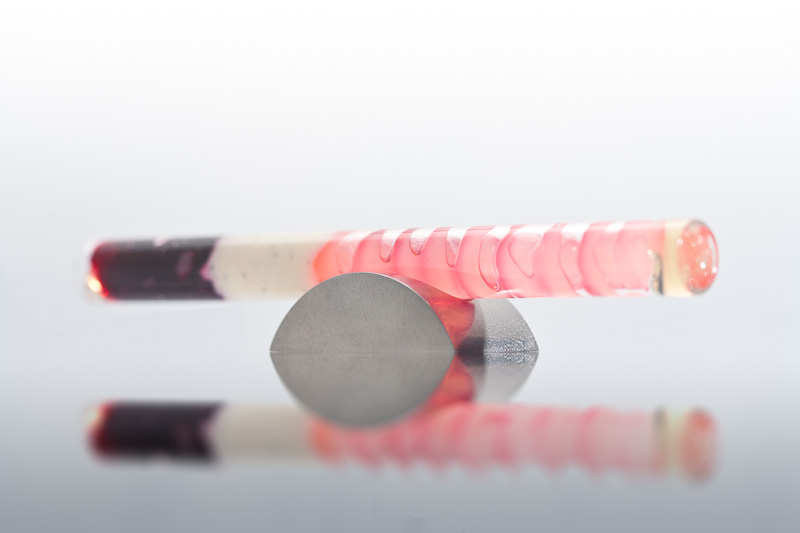
I am just so damn impressed, Allen. Your level of dedication to these dishes is inspirational.
Dang, thanks Andy! And, in the spirit of proffering compliments, may I say I very, very much enjoy reading your own blog; your writing is quite inspirational as well, and always interesting!
Wow! what a great project.
Surprised you saw it through to the end……CNC’ing metal can be quite a daunting task.
Definitely inspiring.
MIke
Hi Mike, sorry for my lag in offering you gratitude for your compliment, but thank you nevertheless!
What a great post, I have been wanting to make this recipe for awhile now. I love the honesty, I tend to do the same thing as well and it can stifle creativity immensely. I love your work, your eye for photos and dedication to these recipes. I wish I had the time and the outise of the box thinking you have when approaching these posts and what all it entails to get here.
Hey thanks Michael, especially for the encouragement about the more-personal stuff. A lot of chefs that I see throwing thoughts onto twitter/facebook/whatever seem to put forth a brusque, confident persona, which often makes me think I need to be that way if I ever hope to be able to hang with any of them. I’m not so good at that though; that aspect of being a professional chef is actually one of the things that keeps me from pursuing it–worrying I might not really have the personality for it. Being able to be expressive here with you and others is much more comfortable for me. So, thanks for that!
Your dedication and OCD in each and every little component, is an inspiration to us all. I think the upside-down pedestal version could be hypnotic if you could make it rock without the tube sliding off, especially with an air bubble in the straw that would oscillate in reverse like a bubble level.
Out of curiosity, what was the straw served on when you went? The first time I went, they had the straw served on a folded cloth napkin, but on my return visit a couple months ago, they replaced the filling with a clear stock with finger lime and mango and they served it on a pedestal of their own. It’s interesting to see the differences in style in yours. Their version is basically 3 curved paper thin sheets of metal welded together to form a triangular clamp on the straw (you can google “finger lime mango Alinea” for images or I can email you mine). It definitely reflects more of the minimalist aesthetic of their other pieces but your straw is probably much easier to pick up without taking the whole pedestal and is visually just as stunning.
I’d love to design my own pieces I’m always too paranoid about what materials are safe to serve food in, so I had found several companies online that sold borosilicate drinking straws of various diameters (Glassdharma even broke them up by purpose: ice tea, smoothies, bubble tea), but it’s interesting to see you shop in terms of raw materials.
Hi Riam, sorry for my delay in responding! When I went, the straw was sitting on a folded napkin just like you describe, though I have seen some photos of the finger lime plating with the thin little clip-looking thing (it was a little hard to make it out from the small photos I saw). Thanks very much for the compliments about my own design attempt! And thanks also for the glassdharma tip…I woulda gone that route had it occurred to me that shopping for glass straws was a ‘thing’. (It turns out, I’m discovering as I go with this, that pretty much EVERYTHING is a ‘thing’ though!)
Happy New Year to you too!
I am so impressed with your recent undertakings. I’m glad that the service pieces and the dish turned out so beautifully. I think your pedestals are ingenious, especially given the constraints of the medium and method and the fact that all you had under your belt was a crash course. Bravo!
I hope that your year is chock-full of fun and making Cool Shit, just like this.
Hey Katie! Thank you so much!
Also, I know you’ve been playing with the Momo milk bar book, right? Sarah got it for christmas and has been making stuff from it as well. It’s nuts! AWESOMELY nuts!
Incredibly awesome, but equally nuts.
Wow. Yes, dedicated and awesomely crazy! Great job though. Glad to see you back on the “Project” again.